
Our Precious Drikung Kagyu Teachers
Short Biography of H.H. Drikung Kyabgon Chetsang Rinpoche TOP
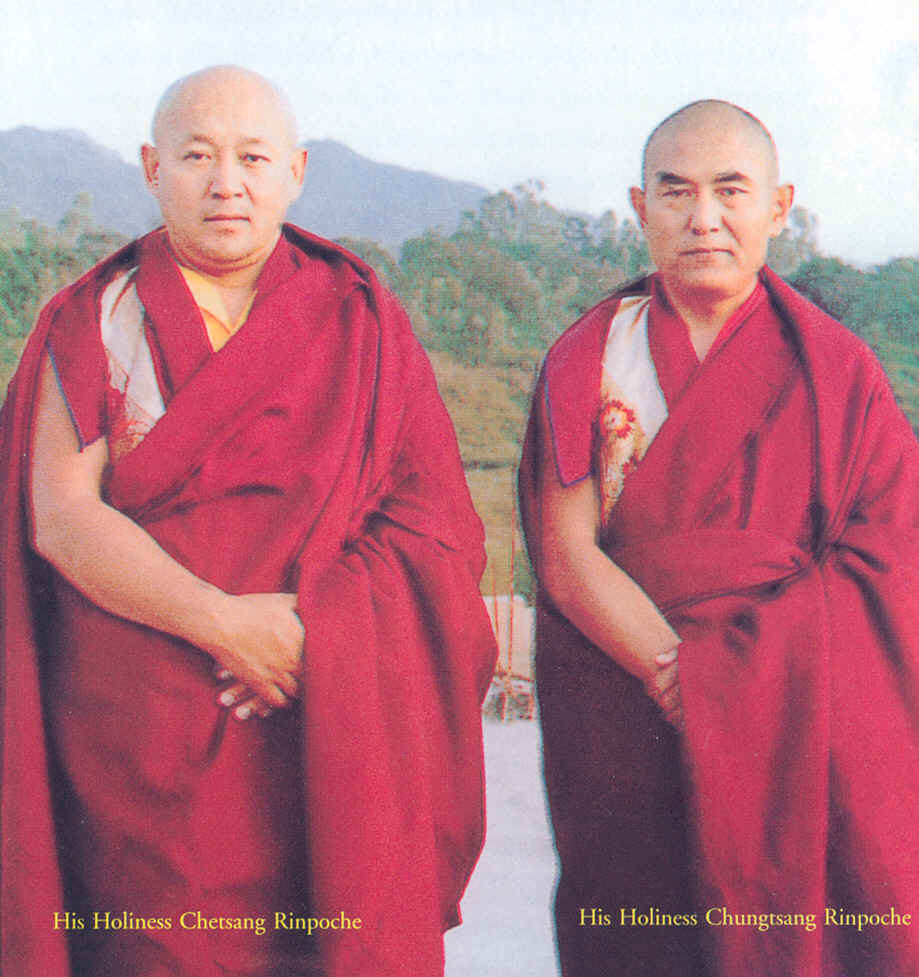 |
H.H. Drikung Kyabgon Chungtsang Rinpoche (on your left) H.H. Drikung Kyabgon Chetsang Rinpoche (on you right) |
His Holiness Drikung Kyabgon Chetsang Rinpoche
Short Biography
His Holiness Drikung Kyabgon Chetsang, the 37th throne holder of the Drikung Kagyu Lineage and 7th reincarnation of the Chetsang Rinpoche is a manifestation of Chenrezig (Avalokiteshvara).
Drikung Kyabgon Chetsang, Konchog Tenzin Kunsang Thrinle Lhundrup, was born on the 4th day of the 6th Tibetan month of the Fire-Dog-Year 1946 into the aristocratic family of Tsarong in Lhasa. This auspicious day marks the anniversary of the Buddha’s first turning of the Wheel of Dharma. Many prodigious signs and visions accompanied his birth. His grandfather, Dasang Damdul Tsarong (1888-1959), has been the favorite of the 13th Dalai Lama (1876-1933), Commander General of the Tibetan army and one of the most influential political figures in the early 20th century in Tibet. Chetsangs father, Dundul Namgyal Tsarong (b. 1920), held a high office in the Tibetan Government and he was still active in important positions for the Exile Government in Dharamsala after the escape of the Dalai Lama and the cabinet ministers. His mother, Yangchen Dolkar, is from the noble house of Ragashar, which descended from the ancient royal dynasty.
Few years after the passing of the previous Drikung Kyabgon, Shiwe Lodro (1886-1943), two parties began to look for his reincarnation throughout Tibet. Based on a vision of the Drikung regent Tritsab Gyabra Rinpoche (1924-1979) at the oracular lake Lhamo Latso and on many additional divinatory signs, in 1950 the son of the Tsarong family was recognized as the reincarnation of the Drikung Kyabgon. The boy subsequently passed numerous tests, such as identifying religious items and ritual objects of his former incarnations. His incarnation was further confirmed by divinations performed by Taktra Rinpoche (the Regent of Tibet), H.H. the 16th Karmapa Rangjung Rigpe Dorje, and H.H. Taklung Matrul.
In the fall of 1950 the formal enthronement as Drikung Kyabgon Chetsang took place at Drikung Thil, the main monastery of the Drikung Kagyu order. Immediately thereafter the first Chinese invasion of Tibet took place. Rinpoche was allowed to travel to Kalimpong in Northern India with his family, in order to stay in a safe place. His older brother and his two sisters were attending boarding-schools in Darjeeling. After some months Rinpoche was met by a delegation from the Drikung monastery and brought back to Tibet.
According to ancient tradition, Chetsang Rinpoche resided in turns in one of the four main monasteries: In the spring in Drikung Tse, during the summer in Yangrigar, in autumn in Drikung Thil, and during the winter in Drikung Dzong, which also served as the administrative center of Drikung. His spiritual instructors (yongzin), Tritsab Gyabra Rinpoche and Ayang Thubten Rinpoche (1899-1966), were responsible for his education. His curriculum included reading, writing, memorizing, astrology, and grammar. From his yongzin and from Bhalok Thupten Chodrak Rinpoche, Lho Bongtrul Rinpoche, and Nyidzong Tripa he received the basic empowerments, transmissions, and teachings of the Kagyu tradition and the Drikung Kagyu tradition in particular.
At the age of eleven, Drikung Kyabgon gave his first public teaching and transmission, a long-life empowerment, during the 1956 Monkey Year ceremonies of the Great Drikung Phowa. Subsequently he began his philosophical studies at the Nyima Changra monastic college of Drikung. Although he was four years younger he studied together with the second Drikung lineage holder, Chungtsang Rinpoche. His instructor was Bopa Tulku Dongag Tenpa (1907-1959), introducing him to the philosophy of Madhyamaka. He first studied basic texts, like The 37 Practices of a Bodhisattva by Ngulchu Thogme Zangpo and Introduction to the Bodhisattva's Way of Life (Bodhicharyāvatāra) by Shāntideva.
Soon thereafter Tibet underwent a great upheaval. In the wake of the Tibetan uprising of 1959, as many Tibetans fled the country, among them the Dalai Lama, the cabinet ministers and a host of spiritual dignitaries, several attempts were launched to bring Chetsang Rinpoche and Chungtsang Rinpoche out of Tibet into safety. These attempts failed because of the inexorable resistance of the monastery manager. Rinpoche’s family had already fled to India in 1956.
The monks in the Drikung monastery were put under house arrest, and Chetsang Rinpoche had to endure with them for months Communist indoctrinations. After some month Tritsab Gyabra, who had left the monastery some years before, took Rinpoche to live with him in Lhasa under rather dismal conditions. In 1960, Drikung Kyabgon was admitted into an elementary school in Lhasa. In very short time he mastered the subject matters of several classes, being able to finish the six years of education in only three years. Thereafter he was admitted to the Jerag Lingka middle school. The subjects there included Chinese, natural sciences, history, and biology. Chetsang Rinpoche excelled in his studies, especially in Chinese. He also became a keen athlete and a passionate and brilliant soccer player.
When the Red Guards infiltrated the schools at the onset of the Cultural Revolution in 1966, Chetsang Rinpoche found himself caught up in the midst of the factional fighting of two opposing groups of Red Guards. Classes and business came to a halt. Many aristocrats and Rinpoches had to undergo brutal “people’s tribunals” known as struggle sessions. Chetsang could no longer stay with Tritsab Gyabra, who had fallen from grace. He lived at the school, where he cooked for the few remaining schoolmates and studied the books he found in the school’s library. Lhasa sank into chaos. In this atmosphere of anarchy Rinpoche several times was saved by a fraction from certain death.
In 1969, he was assigned to a commune in the countryside, where he had to carry out the hardest physical labor. A partly decayed verminous shack on top of a sheep pen was his shelter. He did not own more than a pot and a cup and some slats to sleep on. An uncle, who came to visit him one day, struggled against his tears, stunned that his nephew was living in such squalor. But Chetsang Rinpoche always reacted with great equanimity to all the many upheavals in his live. When the uncle became aware of the serene calmness pervading every aspect of Chetsang’s being, he compared him with Milarepa, who lived in comfortless caves and outwardly austere, but inwardly excessively rich spiritual life.
In the spring and in summer Chetsang Rinpoche drudged on the fields of the work unit. In autumn he had to climb high mountains to cut firewood for the commune and carry home heavy loads. In the winter he had to shovel out the sewage from the cesspits in Lhasa and carry it to the farm. Despite the strenuous labor, Chetsang helped others, whenever he could. Nobody knew that he was the Drikung Kyabgon Rinpoche, but his extraordinary deeds amazed many.
Due to his class background as aristocrat and high incarnate lama there was no prospect for Chetsang in Communist occupied Tibet. After meticulous planning, he finally found a means of escape in 1975. This was at a time when China had established a tight system of spies and informers all over Tibet and the military had a close grip of control, so that only few succeeded to take flight. He set out alone and without help to cross the border of Tibet into Nepal across high passes and glaciers. The Drikung Kyabgon accomplished what was thought to be impossible. Unscathed he reached Nepal and eventually the residence of the Dalai Lama at Dharamsala.
Rinpoche conceded to the appeals of the Drikung lamas in exile and so he was again symbolically enthroned as the Drikung Kyabgon during a ceremony with the Dalai Lama. By this act he expressed the promise to take responsibility for the lineage in the future. Initially though, he traveled to the USA, where his parents had in the meantime emigrated to. There he learned English, while earning his living as a part-time at a McDonald's and other restaurants.
During the third year of his stay he received a very rare ancient Tibetan text uncovered in Nepal dealing with the history of the throne holders of the Drikung Order and written by his former incarnation, the 4th Chetsang Peme Gyaltsen (1770-1826). He started analyzing this work and studying the history of Tibet, of the Drikung Kagyu, and of his former incarnations. Shortly thereafter he returned to India in 1978, to take on the lead of the Drikung Kagyu Lineage as its throne holder.
For many years in occupied Tibet and in the USA, Drikung Kyabgon had outwardly led the life of a layman. Nonetheless he had always strictly kept his monk’s vows. Now he resumed his monastic lifestyle once again and took up residence at Phyang Monastery in Ladakh. Instantly he entered a traditional three year retreat at Lamayuru Monastery under the guidance of the stern meditation master Kyunga Sodpa Gyatso (1911-1980).
Drikung Kyabgon studied with numerous highly accomplished lamas and Rinpoches of different traditions and received from them teachings and initiations. He regards Dilgo Khyentse Rinpoche (1910-1991) as one of his most important teachers. He received from him the essential teachings of the Eight Practice Lineages of Tibetan Buddhism (Dam Ngag Dzo), the highest Dzogchen teachings (Nyingtig Yashi), as well as the collected writings of Jamgon Kongtrul (Gyachen Kadzo) and the treasury of the oral Kagyu transmissions (Kagyu Ngag Dzo). In addition he received precious teachings and empowerments from H.H. the Dalai Lama (Chakrasamvara, Kālachakra, and Yamantāka), from H.H. the 16th Karmapa (Six Yogas of Nāropa, Milarepa), from H.H. Taklung Shabdrung Rinpoche (transmission of the Taklung Kagyu teachings) and from H.H. Taklung Tsetrul the Northern Treasures. He studied Buddhist philosophy under Khenpo Noryang in the Drukpa Kagyu monastery Sangnag Choling in Bhutan, who gave him teachings on the Bodhicharyāvatāra by Shāntideva, the Madhyamakāvatāra by Chandrakīrti and on the Uttara Tantra. Khenpo Noryang also transmitted to him teachings of the general Kagyu tradition and the particular teachings of the Drukpa Kagyu on Mahāmudrā. Moreover Chetsang Rinpoche received important Drikung Kagyu empowerments and teachings on Mahāmudrā from H.E. Garchen Rinpoche and Drubwang Konchog Norbu.
In 1985, Drikung Kyabgon received full monk's ordination from His Holiness the Dalai Lama, during the Kalachakra initiation in Bodhgaya. He mastered all challenges with remarkable ease. Since 1987 Chetsang Rinpoche began to give teachings in many countries throughout the world. At the same time he started to rebuild the weakened Drikung Lineage with great energy. In Dehra Dun, India, he established a monastery and an educational center, attracting many monks from Tibet and Buddhist practitioners from many countries: the Drikung Kagyu Institute. In the beginning it consisted of the monastery Jangchubling and the retreat center and nunnery Samtenling. The Drikung Kagyu Institute is an education center, which emphasizes both the traditional monastic education, as well as present-day training to meet the needs of these times. Special consideration is also placed on discipline, meditation practice and the specialties of the Drikung Kagyu teachings. In 2003 Chetsang Rinpoche established near his monastery a magnificent edifice: the Songtsen Library, a center for Tibetan and Himalayan studies. A building epitomizing in content, function and form the essence of his vision as a treasury and think tank for the cultural and spiritual identity of the peoples of the Himalayan region and of the Drikung Lineage in particular. It contains rare texts about all subjects of the Himalayan region, works on Tibetan culture, tradition and geography, and of course the Buddhist texts of all schools. It houses an important collection about the famous Dunhuang manuscripts unearthed along the Silk Road. There, an unimaginable wealth of texts in various languages dating from the 4th to the 11th centuries was discovered. The Tibetan corpus alone includes thousands of manuscripts of all kinds, including the earliest Tibetan medical drawing known at present. Thus these ancient texts provide the researcher with a vast array of source material on the earliest period of Tibet, which Chetsang Rinpoche would like to make accessible in its entirety, as his scope encompasses the preservation of Tibetan culture and religion.
In 2005 close to the Songtsen Library, Drikung Kyabgon built a large College for Higher Buddhist Studies, the Kagyu College. With its inauguration the new Drikung Mandala in Dehra Dun has been completed.
His Holiness now resides primarily at JangChub Ling in Dehra Dun, Northern India. Located at Drikung Kagyu Institute, P.O. Box 48, Sahastradhara Road, Dehra Dun, U.P. India 248001
Long Life Prayer for H.H. Drikung Kyabgon Chetsang Rinpoche
| Embodiment of the three precious jewels, |
| Padmapani, who holds the teachings of the Victorious One, |
| Seeing the all-goodness meaning with the wisdom eye, |
| May you who are Spontaneously Established Activities live long for hundred of kalpas! |
Short Biography of H.H. Drikung Kyabgon Chungtsang Rinpoche TOP
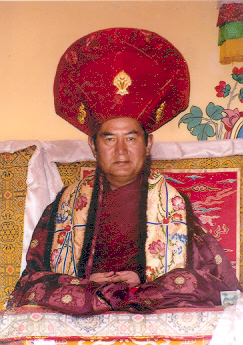 |
His Holiness Drikung
Kyabgon Chungtsang, the 36th throne holder of the Drikung Kagyu
Lineage and the 8th reincarnation of the Chungtsang Rinpoche is a
manifestation of Manjushri.
Drikung Kyabgon Chungtsang, Tenzin Chokyi Nangwa, was born in the
Water-Horse-Year 1942 in Lhokha as the youngest of five sons into the prominent
aristocratic Lhagyari family. His father was Trichen Kelsang Nyendrak and his
mother Rigzin Chodzom. The Lhagyari family is one of the oldest noble houses of
Tibet descending from the ancient royal dynasty. The family branch is called
Dewa Lhagyari Trichen.
After the untimely passing of the 7th Chungtsang Rinpoche, Tenzin
Chökyi Jungne (1909-1940), the youngest son of the Lhagyari family was
recognized as the reincarnation of the Chungtsang Rinpoche in 1946 and was
enthroned in Drikung Thil Monastery. There were many signs, divinations and
consultations of oracles that confirmed his reincarnation. Gyabra Tritsab had a
vision at Lake Lhamo Latso which was substantiated by further divinations by H.H.
the 16th Karmapa and by H.H. Taklung Matrul. The Tibetan Government
authenticated the reincarnation as well, and Chungtsang passed the traditional
test of selecting religious items belonging to former reincarnations.
At the age of eight years he started to learn to read and write, memorize texts,
and to perform rites and rituals. His main spiritual instructor (yongzin) was
first Gar Khensur Tsangyang Norbu Rinpoche, from 1955 onwards Tritsab Gyabra
Rinpoche and Ayang Thubten Rinpoche. He received transmissions, empowerments,
and teachings of the Kagyu tradition and the Drikung Kagyu tradition in
particular by Tritsab Gyabra, Ayang Thubten, Lho Bongtrul Rinpoche, and other
eminent Lamas.
In 1959 after the Tibetan Uprising, Chungtsang Rinpoche had to undergo Communist
indoctrinations and severe struggle sessions at Nyima Changra Shedra, where the
Chinese Army had established their regional headquarters. He was badly
mistreated and in December 1959 he was put in jail. Chungtsang Rinpoche remained
imprisoned for 23 years until 1982. Especially during the times of the Cultural
Revolution he had to undergo harsh re-education programs and to perform forced
labor. At that time he was transferred to the infamous prison camp at Kongpo
Ningtri. There he had to cut down trees in the woods. One day he was hit by a
falling tree and badly injured. It was said that he only survived because he was
the Kyabgon Rinpoche.
Eventually he was released from prison in the course of the political
liberalization of 1983 in China and was given a post in the Regional People’s
Congress and subsequently a leading position in the Department of Religious
Affairs of the Tibet Autonomous Region.
In 1985 for the first time Chungtsang Rinpoche was allowed to travel to India to
meet his brothers who had left the country. He also came to visit the Drikung
monasteries in Ladakh and there he met Chetsang Rinpoche again after 26 years.
The second time he was allowed to travel abroad was in 1992. Chungtsang Rinpoche
came for the inauguration of Drikung Kagyu Institute’s Jangchubling Monastery to
Dehra Dun. As it was a Monkey Year, he gave the traditional Monkey Year
Teachings together with Chetsang Rinpoche. For the Drikungpa the sun and the
moon had finally conjoined again. At that time Chungtsang Rinpoche was promoted
to deputy secretary general of the Office of Religious Affairs in Lhasa, a post
that he still holds today.
Long Life Prayer for H.H. Drikung Kyabgon Chungtsang Rinpoche
Noble Manjushri, the Lord of Speech, |
| who manifests to hold the teachings of the Triple Gem, |
| Who raises the lamp of the Sage's teachings, |
| May you who are the Light of the Dharma live long for hundreds of kalpas! |
His Eminence Garchen Triptrül Rinpoche TOP HOME
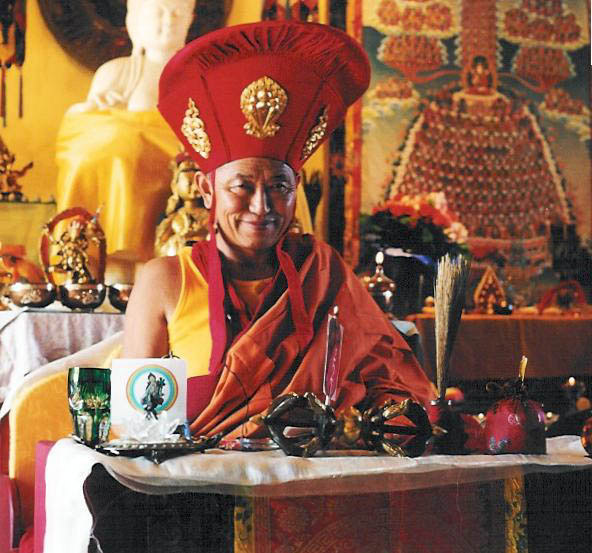 |
More about His Eminence Garchen Rinpoche
The successive line of Kyabje
Garchen Triptrul Rinpoche
Limitless eons in the
past, in this world there appeared a powerful Chakravartin king called Tsib-Kyi
Mu-Khyü, who established the sentient beings in his realm on the path of the ten
virtues. He was the father of a thousand fine princes. Finally, the king became
a monk, attained enlightenment, and became the Tathāgata Light of the Nāgas.
This Buddha turned the Wheel of Dharma extensively and ripened and liberated
countless sentient beings with and without form. His thousand sons all became
monks and gave rise to bodhichitta, except for the youngest, who was attached to
royal life. Their father made a prophecy foretelling the enlightenment of his
sons and which buddha they would become, each one's family, name, and realm to
tame beings. With the intention of establishing his youngest son on the path of
enlightenment, the Tathāgata emanated two monks and sent them off to him.
Chanting sweet songs that taught renunciation, the monks came to the place where
the prince was indulging himself in sensual pleasures. By the power of the
Buddha's compassion, everything in the palace and the trees outside began to
echo the sound of Dharma. The prince's mind changed and he gave rise to
disenchantment with saṃsāra. Then he prepared golden parasols bedecked with
jewels and offered one to his father, the Buddha, and one to each of his
brothers. He gave rise to bodhichitta and became a monk. The Tathāgata Light of
the Nāgas made a prophecy that in a future aeon his thousand sons would become
the thousand buddhas of a fortunate eon. The youngest son will be this eon’s
last buddha, the Buddha Infinite Aspiration. This Buddha's enlightened
activities should exceed those of all the previous buddhas.
Lord Jigten
Sumgön said, "At that time I was the Tathāgata Light of the Nāgas and you, Gar
Chödingpa, were my youngest son, attached to royal life." By the power of the
auspicious aspirations of the Tathāgata Light of the Nāgas and his son in the
past, father and son appeared again together in India as Āchārya Nāgārjuna and
his disciple Aryadeva, and again in Tibet as Lord Jigten Sumgön and his disciple
Gar Chödingpa. Furthermore, Garchen Rinpoche appeared at the time of the Dharma
King Songtsen Gampo as his minister Gar Tongtsen; and as Chogro Lui Gyaltsen,
the disciple of the second Buddha, Padmasambhava; and as Milarepa's heart-son
Rechung Dorje Dragpa. Many of his emanations have also appeared in pure lands,
such as the land of Uddiyāna, the Lion Island, Shambhala, and so forth, where he
acted for the purpose of sentient beings.
When Gar Chödingpa was born as
Gar Tongtsen, he brought back the daughter of the Chinese King Thangthai Dzung
as a queen for King Songtsen Gampo. Together the minister and princess brought a
special prayer wheel. Minister Gar preserved the wheel and, looking into the
future, he concealed it at Sha'ug Tago and sealed it with a prayer that he
reveal and retain it again in the future. Later Gar Chödingpa revealed the
prayer wheel and set it up in a temple in Pumu Phulung below Vajra Rock. Due to
the installation of the prayer wheel, the Phulung monastery started there. He
preserved the welfare of beings for eight incarnations at that place. His eight
incarnation at Phalung Monastery was also his first incarnation at Gar
Monastery, as Gar Tenzin Phüntsog, the son of the king of Nangchen, Karma
Rabten. The 20th throne holder in the Drikung succession relied on the peerless
Dharma King Tenzin Phüntsog as his guru. Achi Chökyi Drölma prophesied to the
sacred master: "Hide the precious prayer wheel in the North at a white rock in
the shape of a lion leaping up into the sky." Following the prophecy of Achi,
who knew that this master and the holy object would bring about the vast benefit
of beings, he traveled from Pumu to Nangchen. As the Sky Fortress of the Lion in
Nangchen was consistent with the prophecy, and because he saw that that place
was endowed with auspicious signs, he settled there. Thus the Gar Monastery, Sky
Fortress of the Lion, was established.
According to Guru Padmasabhava's
prophecy in the great Guhyasamaja Terma revealed by Ratna Lingpa, Tenzin
Phüntsog was an emanation of Avalokiteśvara. Furthermore, it states that if the
cycle of Guhyasamaja teachings and the sacred objects contained in the terma
reached Tenzin Phüntsog's hands, he would bring vast benefit to the sentient
beings of future generations in this world. As the instructions were clearly
defined in the terma, Ratna Lingpa's son Tsewang Dragpa collected the terma
objects and set out to travel from Central Tibet to the Eastern region of Kham,
in search of Tenzin Phüntsog. When they met, he offered the terma objects into
his hands. Tenzin Phüntsog was overjoyed and spoke, "It seems that Guru
Padmasambhava's prophecy corresponds with my name, me an old man." He ate a
small piece of the terma substances and his feet began to hover above the
ground. Ever since, Guhyasamaja Drubchens have been practiced regularly at Gar
Monastery, the Sky Fortress of the Lion, and the precious prayer wheel began to
spin there incessantly. Thus, signs that he would bring about the vast benefit
of sentient beings became apparent. The assembly grew enormously at this place.
Gar Tenzin Phüntsog was appointed the main guru of the king of Nangchen, and
from that time onwards every incarnation of Garchen Rinpoche became the main
guru of the king of Nangchen.
The second incarnation, Gar Tenzin Dragpa,
was recognized by the omniscient Lord Chökyi Dragpa, as the incarnation of the
previous Gar. From the 24th throne holder in the Drikung succession, Je Trinlé
Sangpo, Gar Tenzin Dragpa received and practiced all the profound Drikung
teachings. According to the intention of Mahākāla, as the assembly at the Upper
Monastery became too large, the Lower Monastery Jangchubling was established; it
flourished and prospered.
The third incarnation, Gar Chökyi Nyima,
became the heart-disciple of the 2nd Kyabgön Chungtsang Döndrup Chögyal, the
25th throne holder in the Drikung succession. He reached high levels of
attainment through depending on the practice of Chakrasamvara. He displayed many
signs of accomplishment, such as flying in the sky, hanging his robe on a
sunray, leaving foot and hand prints in rocks, and so forth. Although he
exclusively remained in meditation retreat, he gathered a great assembly of
disciples. The 27th throne holder in the Drikung succession, Kyabgön Chökyi
Nyima, received his instructions of the ultimate lineage. Thus he became the the
sublime lord of the family and his contributions to the Drikung Kagyü teachings
were tremendous. His heart-disciples were Kyabgön Chökyi Nyima and the senior
Lamas - Mingyur and Namröl - and he had many more extraordinary disciples as
well.
The fourth incarnation, Gar Tingdzin Jangchub Wangpo, received,
studied, practiced, and mastered many profound teachings, such as the Fivefold
Path of Mahāmudrā and the Six Yogas of Naropa, according to the Drikung lineage,
as well as the Yangzab and Yamāntaka cycles from Tendzin Chökyi Gyaltsen, the
4th Kyabgön Chungtsang Rinpoche and 29th throne holder in the Drikung
succession, and Hlo Chökyi Gyaltsen. Then he offered many profound Drikung
teachings to Chönyi Norbu, the 5th Kyabgön Chungtsang Rinpoche and 30th throne
holder in the Drikung succession. Thus his activities were extensive.
The fifth incarnation, Garchen Tenpé Dzegyen, also called Tenpé Gyaltsen, was
ordained in the presence of Dilyag Datrül, and he received, studied, and
practiced many empowerments and teachings of the Drikung lineage, in particular
the Yangzab cycle, from the 31st throne holder in the Drikung succession,
Kyabgön Thugjé Nyima. He was a great monk, and held the three sets of vows.
Bestowing the bodhisattva vows and most empowerments and teachings of the
Drikung lineage to the great Tertön Hlo Bongtrül Nüden Dorje, he became the lord
of the lineage.
The sixth incarnation, Garchen Pemé Gyaltsen, was
recognized by the 31st throne holder in the Drikung succession, Kyabgön Thugjé
Nyima, as the incarnation of the previous Gar. However, he passed away shortly
thereafter.
The seventh incarnation, Garchen Trinlé Yongkhyab, was
recognized by the 32nd throne holder in the Drikung succession, Kyabgön Chökyi
Lodrö. From Hlo Bongtrül Nüden Dorje he received most of the empowerments and
teachings of the Drikung lineage, as well as empowerments and transmissions of
several of the tertön's terma teachings. From Gar Ajin he received the Fivefold
Path of Mahāmudrā and the Six Yogas of Naropa. He practiced and mastered them
and attained the state of accomplishment. He took Karzang Chödrön as his
consort. His main disciple was the Siddha Chime Dorje, and many other disciples
from various places who also attained accomplishments, such as Palmé Khyentrül
Künzang Drodül, Rathro Tertön Tashi Namgyal, and Drubwang Gejung. Because he
took another consort it became troublesome to stay at the monastery, and thus he
had to move elsewhere. However, two years later, he was invited back to live at
the monastery again.
The eight incarnation, Garchen Könchog Ngedön Tenpé
Nyima, was born in 1936. At the age of seven, at the order of the king of
Nangchen, he was recognized by Kyabgön Shiwé Lodrö as the incarnation of Gar
Trinley Yongkhyab. At the age of thirteen he entered Hlo Lungkar Monastery where
he remained for for eleven years. From Hlo Bongtrül Tendzin Drodül and the
Supreme Emanation Thubten Nyingpo he received many empowerments and
transmissions of the new and old classes of tantra, and in particular, according
to their own lineage: empowerments and transmissions of the Eight Herukas,
Assemblage of Realization, and Vajrakīlaya, as well as the Dechen Nyingpo. From
Drubwang Gejung he received the Fivefold Path of Mahāmudrā and the Six Yogas of
Naropa. Furthermore, from the Siddha Chime Dorje and the senior Lama Tengye he
received many empowerments and teachings according to the Drikung lineage.
Although he entered the traditional three-year retreat, he was abruptly forced
to end his retreat due to the eruption of political turmoil. At the age of 22,
Rinpoche was forced to
engage in warfare, and was finally arrested. He spent twenty years in prison,
where he was forced to do hard labor and subject to bitter hardships. However,
his mind remained pure and never wavered from his altruistic wish to help
others. He was liked by all his fellow prisoners and became an exemplary role
model of an honorable man. During his time in prison he secretly received
teachings on Dzogchen from Khenpo Münsel. He practiced with fierce determination
and he became the heart-son upon whom Khenpo Münsel transferred ultimate
lineage. Khenpo Münsel. praised him with the words: "Gar Rinpoche is the
emanation of a bodhisattva". Through twenty years of imprisonment and hardships,
Rinpoche was able to transform his body, speech and mind and emerged as a
selfless master of vast compassion and wisdom.
In 1980 Rinpoche was released from prison. On his way to Pemagö to meet his mother, he gathered holy objects that had been contained in the representations of enlightened body, speech, and mind that were demolished in Central Tibet. Then he returned to the monastery, and together with Mingyur Rinpoche he began to rebuild the monastery from the foundation, and thus they reinstated Gar Monastery again. Day and night he fulfilled the hopes and needs of faithful ones from far and wide. Completely forsaking his own purpose, he devoted himself solely to the purpose of others. His renown as a great bodhisattva spread like the wind. The government of Qinghai province granted him the honorary title of: "One Who Always Holds the Intention to Benefit the People." Rinpoche tried to help ease the lives of others in many different ways. As his mind was always filled with the wisdom of perfect bodhichitta, he even granted the gift of fearless refuge to wild animals. He received various other honors due to his extraordinary accomplishments. Not only did he take on responsibility for his own monastery, Rinpoche has devoted himself wholeheartedly to the task of passing on the teachings of the lineage. He supported the entirety of the teachings and all beings in general, and in particular he helped rebuild all the twenty-seven Drikung monasteries in the Kham region and helped them extensively by offering Dharma and material help, directly, indirectly, and in many other ways. In addition, Mingyur Rinpoche kindly began to extensively bestow the Getsül and Gelong monastic vows in various monasteries.
When Rinpoche visited Drubwang Pachung Rinpoche
in Drikung Thil, with great delight Drubwang Pachung Rinpoche placed both his
hands onto Garchen Rinpoche's crown and spoke, "As I am passing the ultimate
lineage to you, you must serve the teachings of the Drikung lineage."
Rinpoche re-established Gar Monastery from a mere cornerstone and developed it
into a monastery even greater than before. He also reinstated the regular
ceremonies that had declined, and the practices flourished again.
In
1997 Rinpoche traveled to India and offered several empowerments and teachings
to the supreme Drikung Kyabgön Chetsang Rinpoche. In addition, Rinpoche bestowed
various empowerments and teachings according to the Drikung lineage at the main
seat of Drikung, Jangchubling, to assemblies of hundreds of disciples on several
separate occasions.
In 1997, Rinpoche first visited the West and then Rinpoche traveled around the world and
turned the Wheel of Dharma for many faithful disciples according to their needs.
Rinpoche teahces especially on the infallible law of karma cause and effect and
the essence teachings of the Thirty-Seven Practices of Bodhisattvas, a
commentary written by the Bodhisattva Ngulchu Thogme Zangpo..
So far Rinpoche has traveled to thirty-three countries . Only a fraction of his
enlightened activities can be mentioned here. Rinpoche has opened more than
twenty dharma centers around the world; in Kham Rinpoche still supports the
Drikung monasteries extensively; he has established a stable, steadfast and
perfectly completed ground by rebuilding the Upper and Lower Monasteries, as
well as the nunnery; and in addition, he has established a retreat center, a
college, and a clinic. Furthermore, he founded schools at five places affiliated
with him.
Garchen Rinpoche’s vast realization, love and compassion with
the sole wish to benefit all beings without exception are highly revered not
only by masters and disciples of his own lineage but also masters and disciples
of other traditions as well. He always holds a prayer wheel in his hand,
continuously spins the wheel to pray for, and to radiate compassionate energy to
benefit all beings. The great compassionate Tara is Garchen Rinpoche’s main
yidam deity and his aspiration is to follow in her footsteps to bring love and
compassion to all.
Long
Life Prayer for His Eminence Garchen Rinpoche
OṀ
SWASTI.
Unchanging great bliss, Dharmakāya;
unceasing manifold creativity, Sambhogakāya;
dance of non-objectifying compassion, Nirmanakāya
–
protector, in nature the indivisible three kāyas,
protect us!
In the center of a white lotus, sixteen*,
complete
with all qualities, white as an autumn moon,
holding an utpala, protecting from the eight fears
– mother of the three times’ victors –
Wish-fulfilling wheel, bestow immortal life!
The one known in the Holy Land as
Āryadeva
emanated into the Gar clan in Dokham as
Chödingpa, the heart son of JigtenSumgön.
May the life of glorious Garchen remain steadfast
for a hundred aeons!
The full moon, ornament of the three jewels’
teaching, clearly arisen above the shoulder of the
eastern mountains; yet its cool rays nurture the
white lilies of the lower slopes. May the life of Garchen, the
moon that benefits others, remain steadfast!
Casting to the wind three concerns for food, clothing
and fame, wearing the three armor of accomplished wisdom,
virtue and a good heart. The three samadhis as firm
as the deep ocean – May the life of Garchen, lampflame
of definitive meaning, remain steadfast!
In this age of degeneration when the Victor’s teaching
is feeble, through his powerful, vajra-like conduct,
he takes on heavy responsibility of the unbiased teaching.
May the life of Garchen, the sun of the teaching, remain steadfast!
There is no chance for demonic obstacles to affect
the three secrets of the lama who possesses blessings;
yet, in accord with the principle of dependent origination,
this supplication of the wish-fulfilling jewel is marvelous!
By the power of the compassionate truth
of the three jewels and three roots, and through the might
of Mahākala
and ChökyiDrölma, may these words
of benediction made with pure heart be accordingly
and spontaneously accomplished without hindrance!
*
“sixteen”
refers to Tara’s age
Of the water-monkey
year in the 17thcycle
in accord with all aspirations by Könchog
Tenzin Künzang
Trinle Lhündrub, the one
blessed
with the name of the Victorious
Drigungpa.
May it bring virtue.
This prayer was translated from the Tibetan by Jakob Leschly in 1998, with
slight adaptions by Jan-Ulrich Sobisch in 2015.
His Eminence Thritsab Gyabra Rinpoche TOP
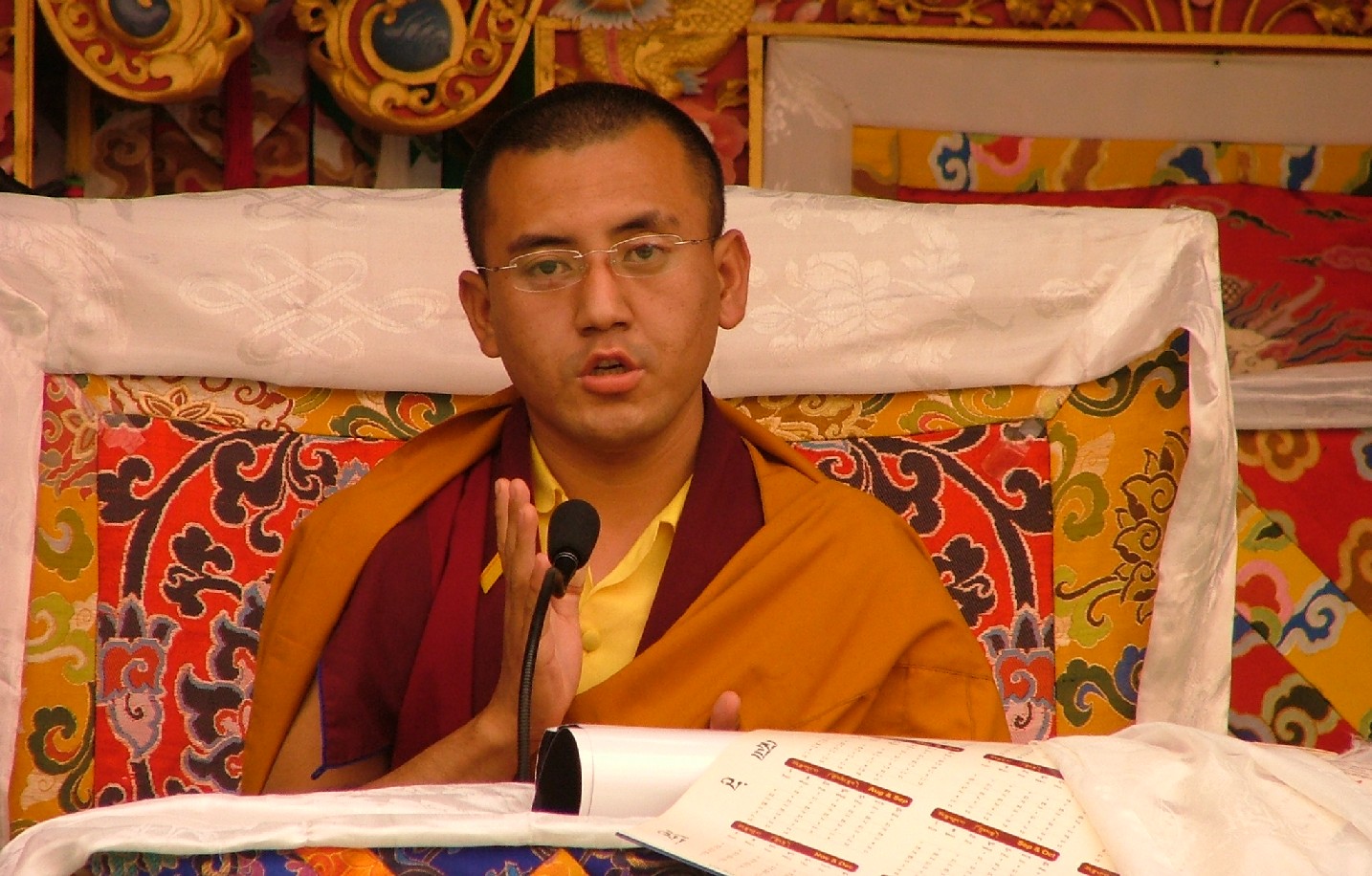 |
His Eminence Thritsab Gyabra Rinpoche is a reincarnation of the second Drikung Kagyu Throne Holder Khenchen Tsultrim Dorje (Vow Vajra, 1154-1221). Khenchen Tsultrim Dorje was ordained at a very young age and at the age of forty-six he traveled to Drikung Thil Monastery in Tibet to pay his respects to Lord Jigten Sumgon. Upon meeting with Lord Jigten Sumgon, he felt an immediate strong connection with Lord Jigten Sumgon. From then onwards, he stayed by Lord Jigten Sumgon's side and obtained all the essential teachings from Lord Jigten Sumgon.
His Eminence Thritsab Gyabra Rinpoche's last reincarnation Gyabra Thubten (1921-1979) was the heart disciple of His Holiness the Drikung Kyabgon Chetsang Rinpoche and His Holiness Drikung Kyabgon Chungtsang Rinpoche of that time. After the two Holinesses passed away, he became the acting head of the Drikung Kagyu Order of Tibetan Buddhism. Upon the recognition of the reincarnation of the two present Holinesses, he became responsible for their education. Thritsab Rinpoche also transmitted all the dharma teachings, empowerments and practices of the Drikung Kagyu lineage to the two reincarnated Holinesses and other Lamas. In the history of the Drikung Kagyu lineage, His Eminence Thritsab Gyabra Rinpoche can be considered one of the teachers who have made the greatest contribution to the Drikung Kagyu lineage.
The present Thritsab Rinpoche (the seventh reincarnation) was born in India on 10 February 1981. H.E. Thritsab Rinpoche was recognized by His Holiness Chetsang Rinpoche in 1986 and was officially enthroned on the 14th January (Tibetan calendar) in 1990. Following the footsteps of the great masters of the past, he did his three year retreat during the period 1996-1999 in order to undertake the task to benefit all sentient beings.
His Eminence Thritsab Gyabra Rinpoche took full monastic ordination in front of His Holiness Chetsang Rinpoche and other Khenpos and masters in 2001. In the same year, His Holiness Chetsang Rinpoche also announced that His Eminence Thritsab Gyabra Rinpoche would be representing him in handling all the matters in Drikung Kagyu Lineage in future.
His Eminence the 12th Nubpa Konchok Tenzin Rinpoche TOP
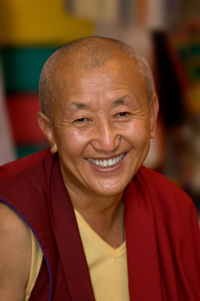 |
After the Lord Buddha's teaching flourished in Tibet, the New Secret Mantra
Doctrine developed. This Doctrine was based on the Lord Buddha's Teaching.
The great translator, Marpa, developed the Kagyu lineage during this "New
Secret Mantra Doctrine" period. The Kagyu lineage then flourished in Tibet.
From this very lineage there have been many highly accomplished masters and
yogis, such as the Great Yogi, Milarepa; Dagpo Rinpoche; and Phagmo Drubpa.
The main disciple of Phagmo Drubpa was Lord Jigten Sumgon (1143 to 1217). He
is the founder of the Drikung Kagyu Lineage. At the age of 37, Lord Jigten Sumgon established Drikung Thil Monastery, the head monastery of the entire Drikung Kagyu Lineage. Lord Jigten Sumgon had countless followers. Previously, a Dharma King of Tibet (blood lineage) had come from western Tibet {Ngari} to the Drikung region and had settled there. One of the descendants of this king took his novice ordination vows from Lord Jigten Sumgon. His name was Nangso Lhopon. At that time, and up until this day, there were two sections in the Drikung Thil Monastic Community. One is known as Ling Tod, and the other as Ling Med, which literally means "upper continent" and "lower continent", respectively. Nangso Lhopon became the spiritual master of Ling Med. He guided the monks spiritually, as well as provided for their daily needs. During the lifetime of Nangso Lhopon, both Drikung Thil Monastic Communities had abbots, spiritual masters, and a disciplinarian. The residential palace of Nangso Lhopon, "Nubpa Lhadrang", was located west of the main shrine hall of the Drikung Thil Monastery. He thus became known as Nubpa Rinpoche, which means "precious one of the west" in Tibetan. From Nangso Lhopan, or Nubpa Rinpoche, there has been a continuous line of reincarnations right up until this present age, which is known as the "Degeneration Era".
One of the reincarnations of Nangso Lhopon, Jamyang Rinchen, was born at the time of the 16th Drikung Throne Holder, Gyalwang Kunga Rinchen (1475 to 1527). This Throne Holder, Gyalwang Kunga Rinchen, was recognized as the reincarnation of Lord Jigten Sumgon. |
Jamyang Rinchen became the main disciple of Gyalwang Kunga Rinchen. As in his
former life, Jamyang Rinchen again took care of and guided the monks at Drikung
Ling Med. The important accomplishment of constructing Achi Prayer Hall (known
today as Achi Khang) was one of his many virtuous deeds and activities.
Jamyang Rinchen's brother, Gonpo Gyaltsen, was the military commander of the
Drikung region, while Gyalwang Kunga Rinchen remained the spiritual leader.
At that time in Tibet there were a multitude of regions, and with each region
having its own king, battles were common. As military commander, Gonpo Gyaltsen
had been involved in much warfare. He was responsible for defeating the
opponents of the Dharma in the surrounding regions. He saved Drikung Thil
Monastery and its contents of sacred Buddhist scriptures from destruction.
During battle Gonpo Gyaltsen appeared to some in the form of the four-armed
Mahakala, black faced and terrifying. He is therefore seen as a real
manifestation of the four-armed Mahakala.
Gonpo Gyaltsen performed many great Dharma activities as well. He built the
four-armed Mahakala statue at Nubpa Lhadrang, and during the consecration of
this statue he offered his battle sword and placed it at the level of Mahakala's
heart. Thereafter the Mahakala statue became very powerful and effective for
those who worshiped there. In the past and to this day, there are many
emanations of Mahakala in the form of black crows, snow lions, etc.
Nowadays we can see the natural body shape of these emanations on the rocks
around the Mahakala Shrine Hall. A very special aspect of this four- armed
Mahakala statue is that no particle of dust has ever settled on it; it remains
perpetually shiny and clean -- a perfect representation of Divine Wisdom.
Whomever sleeps even one night at the Nubpa Lhadrang is said to be blessed with
what amounts to the Complete Accomplishment Practice of the four-armed Mahakala.
The two brothers have been reincarnates from that time until this "Degeneration
Era". The present Nubpa Rinpoche is the reincarnation of Gonpo Gyaltsen, the
emanation of four-armed Mahakala. He is also the reincarnation of the 11th Nubpa,
Konchok Tenzin Mepham Gopo.
Our present Rinpoche, the 12th Nubpa Konchok Tenzin Rinpoche,
was born in 1942
and was recognized (while still in
his mother's womb) by the 34th Drikung Throne Holder, His Holiness Shewe Lodro
(1874-1945). Rinpoche was enthroned when he was only five years old and started
formal studies at the age of six. He learned Tibetan scripture and ritual
practices from Pasang until the age of 14. At 15, he joined the Sun-ray Garden
Institute (Nyichang Shedra, located near Drikung Thil Monastery) for higher
Buddhist philosophical and Tantric studies.
Nubpa Rinpoche has received all of the Drikung Protector initiations and
transmissions from H.E. Lho Drongtul Rinpoche. He has received all of the Fifty
Collections of Initiation, the Treasure of Kagyu Instructions, the Treasure
Discoverer Yangzab teaching (by Gyalwang Rinchen Phuntsok), and the Yamantaka
from Regent H.E. Tritsab Rinpoche, as well as the Nyingma Collection of
Initiations from the previous H.E. Nyizong Tripa Rinpoche.
By 1959, Rinpoche had mastered the Chinese language. By 1966, due to the
political changes in Tibet, he had learned the ways of the farmer. Returning to
Lhasa in 1974, he found work as a stone mason, but in 1979, Rinpoche resumed his
academic career as the editor of the magazine, the "Tibetan Buddhist
Association". In 1989, under the arrangement of the 10th Pachen Lama, Rinpoche
joined the Peking Buddhist College of Higher Studies and there received his
academic degree.
Rinpoche always says that his time spent learning about Buddhist teachings was
very precious, as were the oral transmissions he received from Pachung
Vajradhara, Khenchen Jigmey Phuntsok, and Gyendun Gyatso, among others.
In 1992, he arrived in India to serve His Holiness Drikung Kyabgon Trinley
Lhundub, his root Guru, who was then working to preserve the Drikung Lineage.
While there, Rinpoche became the supervisor for the re-publications of the 24th
Drikung Throne Holder's, His Holiness Kunkhen Ringzen Chodrak's (1595 to 1659),
fifteen volume compendium of transcribed oral instructions from the Tibetan
Buddhist tradition {Kabum}. Rinpoche was also appointed as the headmaster for
the Drikung Kagyu Institute, JangChubLing. Rinpoche has received many authentic teachings and
oral transmissions from those living and parinirvana masters.
When Rinpoche first visited Lapchi in 1998, he had planned to undergo long
periods of retreat there. However, when he found out about the difficulties
faced by the monks, practitioners and villagers in Lapchi, he could not bear to
see this holy place decline. Hence, out of great compassion, Rinpoche decided to
undergo short periods of retreat in Lapchi for the time being, so that he could
propagate the Dharma to benefit sentient beings and to work on the restoration
of Lapchi at the same time. Up to 2010, Rinpoche has completed an extended
retreat of four years in Lapchi (the holiest place of Yogi Jetsun Milarepa) and
spent a total of seven years there. Due to Rinpoche's altruistic mind of enlightenment, over thirty
practitioners have gathered on "conduct" retreats under his guidance in that
holy place.
As a result of the late H.E. Drubwang Konchok Norbu Rinpoche's and H.E. Nubpa Rinpoche's loving kindness and compassion, the building of the Drikung Kagyu Rinchen Ling Monastery in Nayapati, Nepal has also been inaugurated for the sake of all Dharma practitioners in 2009. Drikung Kagyu Rinchen Ling Monastery and all Drikung retreat places in Lapchi are cuurently under the care and guidance of H.E. Nubpa Rinpoche.
In October 2011, The Hundred Thousand Milarepa Boom Tsog in Lapchi led by H.E. Nubpa Rinpochea was attended by a total of around 100 persons including 42 foreigners, 11 monks from Rinchen Ling Monastery, 18 retreatants from lapchi, 5 monks from Chora Gephel Ling Monastery, 24 sanghas from nepal and overseas and Tibetan pilgrims from around the area. Again in March - The documentary film of the event can be found here. April 2015, led by His Holiness Chetsang Rinpoche tnd H.E. Nubpa Rinpoche, many devotees from all over the world had the fortune to complete the Hundred Thousand Milarepa Boom Tsog in Lapchi. The documentary film of the event can be found here.
Rinpoche is
well-versed and thoroughly realized on the teachings in Sutra text, Abhidharma
and Mahamudra. His Eminence Garchen Rinpoche has mentioned that H.E. Nubpa
Rinpoche is the heart son of the late Mahasiddha, His Eminence Drubwang Konchok
Norbu Rinpoche. The most Venerable Drubwang Rinpoche himself has also mentioned
that His Eminence Nubpa Rinpoche is an authentic practitioner of the Buddha
Dharma whom we can trust and seek advice on our Dharma practice. Those who
are most fortunate to have met and received teachings from Rinpoche would have
experienced the trust, tranquility and geniune compassion that Rinpoche emitted
from his activities and conduct.
H.E. Garchen Rinpoche recently communicated the following about Nubpa Rinpoche:
“He is one of the most special gurus in the Drikung Kagyu lineage and became the main successor of Drubwang Rinpoche after his passing. I met Nubpa Rinpoche for the first time in 1980 after I was released from prison. He then went to Jangchub Ling and served as a great scholar, and after that he completed many years of retreat in Lapchi where he mastered meditation practice. He is thus an accomplished master and also a great scholar of Buddhist scriptures. In terms of practice, he is the successor of Drubwang Rinpoche.
“We have tried to invite him to our center for many years, but only this year has it become possible for him to grant us a visit. It is thus extremely important that all Dharma friends come from all over to meet and learn from him and be able to practice with him.”
Like Drubwang Rinpoche, Nubpa Rinpoche is an extraordinary Chenrezig practitioner, and it is Nubpa Rinpoche who wrote the seven-line prayer for Garchen Rinpoche that is included in Rinpoche’s Guru Yoga sadhana, “Light Amassment of Blessings.”
Long Life Prayer for His Eminence Nubpa Rinpoche
OM SOTI/
Om Svasti.
P'AG PÄ YUL DU DRUB CH'EN TOG TSE PA/
In the land of India you were born as Great Mahasidha Tog Tsepa.
GANG JONG DRUB PÄ TI NÄ DRI GUNG DU/
In the land of snow at the place of Drikung Thil,
GYAL WANG KUN GÄ T'RIN LÄ GÖN PÖ TS'ÄN/
you have emanated as victory Kunga Thinley.
KÖN CH'OG TÄN DSIN KAL GYÄR SCHAB TÄN SOL/
May you, Nubpa Konchok Tenzin Rinpoche, remain steadfast for hundreds of econs.
SCHUNG LUG RIG PÄ NÄ LA P'UL DU CH'IN/
You have culminated all the knowledge of scriptures and science,
DRIB PÄ SAR SCHUG BÄ PÄ NAL CHOR TSH'E/
you are a presence in the world with great hidden yogic accomplishment.
NYIG MÄ DÜ SU DRUB PÄ GYAL TS'ÄN DRENG/
You are the victory banner of the lineage in this degeneration time.
KÖN CH'OG TÄN DSIN KAL GYÄR SCHAB TÄN SOL/
May you, Nubpa Konchok Tenzin Rinpoche, remain steadfast for hundreds of econs.
This long life prayer was composed on the 15th day of the 6th lunar month (2006) by Konchok Tenzin Kunzang Thinley Lhundrub who is blessed with the name of Gyalwa Drikungpa. It was requested by monk Zodpa. Translated by Lama Nyandak.
More about His Eminence Nubpa Rinpoche can be found here
Biography in Swedish
Hans Eminens Nubpa Konchok Tenzin Rinpoche igenkändes som den 12:e Nubpa Rinpoche (redan innan födseln i livmodern) av den 34:e Drikung troninnehavaren Hans Helighet Shewe Lodro (1874 – 1945). Rinpoche kröntes när han var bara fem år gammal och påbörjade formella studier vid 6 års ålder. Han lärde sig tibetanska skrifter och rituella utövningar av Pasang Rinpoche tills han var fjorton år. Därefter började han vid Nyichang Shedra (intill klostret i Drikung Thil) för högre studier i buddhistisk filosofi och tantriska studier.
Nubpa Rinpoche har mottaget alla Drikung-beskyddarnas initieringar och överföringar från Hans Eminens Lho Drongtul Rinpoche. Han har fått motta Fifty Collections of Initiation, Treasure of Kagyu Instructions och Treasure Discoverer Yangzab från Gyalwang Rinchen Phuntsok samt Yamantaka ifrån Regent Hans Eminens Tritsab Rinpoche såväl som Nyingma Collection of Initiations ifrån den förre Hans Eminens Nyizong Tripa Rinpoche.
Rinpoche hade lärt sig att behärska det kinesiska språket 1959. På grund av de politiska förändringarna i Tibet hade han skolat sig till jordbrukare 1966. Vid återkomsten till Lhasa 1974 fann han arbete som stenhuggare men återupptog 1979 sin akademiska karriär som redaktör för tidskriften Tibetan Buddhist Association. Med stöd av 10:e Pachen Lama kunde Rinpoche 1989 börja vid Peking Buddhist College of Higher Studies där han sedan fick en akademisk examen.
Rinpoche betonar alltid hur värdefull tiden var som han ägnat åt att studera Dharma liksom de muntliga överföringarna som han mottog från Pachung Vajradhara, Khenchen Jigmey Phuntsok, Gyendun Gyatso och många andra.
1992 anlände Rinpoche till Indien för att assistera Hans Helighet Drikung Kyabgon Trinley Lhundub (hans rot-lama) som då arbetade med att bevara Drikung-traditionen. Rinpoche fick ansvaret att överse nyutgivningen av den 24:e Drikung-tronhållaren Hans Helighet Kunkhen Ringzen Chodraks (1595 – 1659) femton volymers kompendium med nedskrivna muntliga instruktioner från den tibetanska buddhistiska traditionen (Kabum). Rinpoche har mottaget många autentiska undervisningar och muntliga överföringar från såväl levande som mästare i parinirvana.
Sedan denna tid har Rinpoche tagit varje möjlighet att göra retreater i Labchi, den heligaste platsen av Yogin Jetsun Milarepa. Retreaterna innefattar en mycket ansträngande veckolång vandring för att nå Labchi. Rinpoche gjorde en längre retreat där som varade i mer än tre år och därefter ytterligare fyra besök. Tack vare Rinpoches altruistiska bodhicitta samlas idag fler än trettio utövare för ”conduct” retreater under Rinpoches ledning på denna heliga plats.
Venerable Rabsang Tulku Rinpoche TOP
 |
|
Rabsang Rinpoche is the reincarnation of Drubwang Rabsang Rinpoche who
was born in a nomad's family in Traga district of Tibet, and was
ordained as Konchok Rabsang. As a young monk, Drubwang Rabsang Rinpoche
learnt Tibetan and various texts and rituals. He received various
transmissions and empowerments of the Drigung lineage from the two His
Holiness Drigung Kyabgon Chungtsang Rinpoche Chokyi Lodro and Chetsang
Rinpoche Zhiwe Lodro. From the Drigung Thil Monastery retreat master,
Drubwang Triyin Osel, he received the Five Limbs of Mahamudra and the
Six Yogas of Naropa and went into a strict retreat. After that he
received from his teacher Tulku Jamyang Wangje the transmissions and
empowerments of thirteen classes as well as the Longchen Nyingthig.
Drubwang Rabsang Rinpoche then went again into long term retreat in the
practice of Mahamudra, and also the profound path of perfection, gaining
a very high realization. Many tulkus of that time made the journey to
see him to receive instructions on the profound path of perfection. When
he passed on at over 70 years of age, Drubwang Rabsang Rinpoche's body
shrank tremendously. When his body was finally laid to rest in the
mountains, it reduced itself to nothing but hair and nails, an evident
sign that he has achieved the rainbow light body.
The current reincarnation, Rabsang Rinpoche, Konchok Tsultrim Rabsel,
was born in 1973, the Water Ox year in a village in Tashi Jung, near the
Drigung Thil Monastery. His father Konchok Thinley and mother Laisang,
saw various auspicious signs during his birth. Since he was a young
child, Rabsang Rinpoche has always been very compassionate to all
animals, and very devoted to the Dharma, always asking his parents to
visit the monasteries. Hence, his parents brought him before the great
Drubwang Pachung Rinpoche, who told them:" this child has a very
meritorious and virtuous connection, his wisdom will manifest in the
future once he has been ordained." So Rabsang Rinpoche was ordained at
Drigung Thil Monastery under Pachung Rinpoche, and was named Konchok
Tsultrim. He studied intensely the various teachings and rituals,
subsequently, visiting HH the 14th Dalai Lama as well as the two HH
Drigung Kyabgon Rinpoches. He has also studied Sutras and Tantras at the
Drigung Institute and Thrangu Institute.
In 1999, during the Snake Year Drigung Prayer Festival, HH the Drigung Kyabgon Chetsang Rinpoche recognized Rabsang Rinpoche as the reincarnation of Drubwang Rabsang Rinpoche and named him Konchok Gyurme Rabsel. He was also enthroned then. Since then, Rabsang Rinpoche received many teachings, transmissions and empowerments from the two HH Drigung Kyabgon Rinpoches, HE Drubwang Konchok Norbu Rinpoche, HE Thrangu Rinpoche, HE Nubpa Rinpoche, HE Khenchen Konchok Gyaltsen Rinpoche and many other great teachers. Rabsang Rinpoche currently resides in Rinchen Ling Monastery, Nepal and actively taking care of the monks and monastery.
Following the footsteps of late HE Drubwang Konchok Norbu Rinpoche, Rinpoche regularly visits a few
countries abroad, especially Singapore and Malaysia, leading the 100
million Mani Recitation Retreat that was consecrated by HE Drubwang
Konchok Norbu Rinpoche and bestowing Dharma teachings. Rinpoche has
already led and attended 100 million Mani Recitation Retreat for
more than twenty times in Nepal and abroad. |
Venerable Drubpon Trinley Yeshi Rinpoche TOP
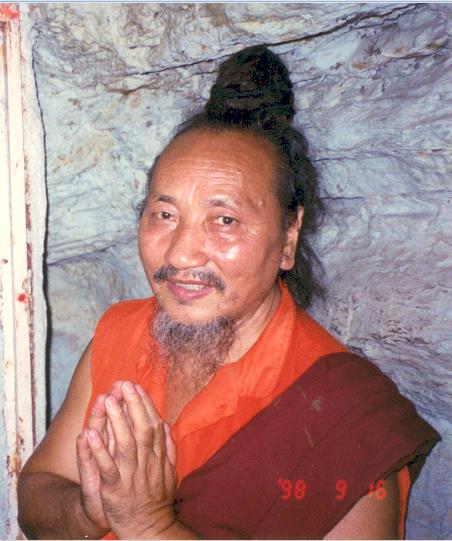
|
Drubpon Trinley Yeshi Rinpoche has in the past served as the head retreat master at the Drikung Kagyu Institute in India. He was born at Drikung Yangre Gar in 1941, near the village of Trolung. His father is Dang Drung and his mother is Dolma. At the age of 12 he took the novice monk vows from H.E. Thritsab Thubten Wangpo (the former Thritsab Rinpoche). Afterwards he became perfectly well trained on how to play ritual instruments, how to chant, perform ritual ceremony, and the traditional Lama dance. At the age of thirty he took the full ordination vows from late master Pachung Rinpoche; hence he has received many teachings from Pachung Rinpoche and his close disciple, fully ordained Tenzin Nyima Rinpoche. Under the guidance of Pachung Rinpoche and Tenzin Nyima Rinpoche, he has perfectly completed his three-year retreat on the Five-fold path of Mahamudra and Six yoga’s of Naropa at Drikung Thil Monastery.
After his beloved Pachung Rinpoche
passed away, he constructed a commemoration Stupa for his teacher. He has also
performed many ritual ceremonies for his teacher through his body, speech and
mind, uninterruptedly. Rinpoche is someone who was able to please his teacher
with his enthusiasm in the practice of Dharma. For three years he has done a
strict sealed retreat on Mahamudra, day and night.
During 1992, Rinpoche received all the Drikung Kagyu lineage
empowerments and oral transmissions from various Drikung Kagyu masters, in
particular from H.H. Chetsang Rinpoche during the Monkey Year teachings. He has
also received teachings from different masters, in particular from H.H. Dalai
Lama. Afterwards he went on a pilgrimage to holy places of the Buddha in India.
Then H.H. Chetsang Rinpoche asked him to lead the Three-year retreat for
Rinpoche’s monks and nuns. Meanwhile His Holiness appointed Rinpoche as one of
the head retreat masters in the Drikung Kagyu Lineage. At that time, he was also
appointed as Dorzin (The representative of the head of lineage) for the holy
place of Labchi. In the year 1996, he led the traditional three-year retreat,
hands-on instruction from the late Drubwang Pachung Rinpoche to twenty-three
monks and nuns including H.E. Thritsab Rinpoche, Senge Tenzin Rinpoche, Lama
Kunsang Rinpoche, Konchog Khandro, Lama Konchog Sangya Rinpoche and so on at
Almora, India. His Holiness stressed to all the practitioners who were in
three-year retreat, that Drubpon Yeshi Rinpoche is someone who has perfected his
understanding in the pith instructions and practice. After a successful
three-year retreat, H.H. highly praised Drubpon Yeshi Rinpoche for his excellent
duty in guiding the three-year retreat in a very skillful and enthusiastic way.
In honor of all of his noble activities within the past many years, his many
years of sincere practice, and his realization His Holiness honored him with a
compliment letter and a recognition letter of being an authentic retreat master
within the Drikung Lineage. In Spring 2009, Rinpoche made his first European tour
to confer Dharma teachings to European Dharma friends. This is Rinpoche's
second visit to Europe. Venerable Drubpon Tsering Rinpoche TOP
At the age of eight, Rinpoche took refuge from His Eminence Garchen
Rinpoche. Three years later, Tsering Rinpoche received his novice ordination,
the Bodhisattva vow as well as Mahamudra instructions from the great Siddha
Karma Norbu, from the Karma Kagyu School. Since his eleventh year, Rinpoche
lived and studied under the guidance of His Eminence Garchen Rinpoche at Gar
Monastery in East Tibet, where he completed the preliminary practices of the
Drikung Dzogchen Yangzab and the Longchen Nyingthig tradition. At Gar Monastery,
Tsering Rinpoche served as the shrine master for five years, and performed many
ceremonies, rituals, and Drubchens with Garchen Rinpoche. Rinpoche learned and
taught spiritual dances, the playing of ritual instruments, the making of sand
Mandalas, Tormas and the like. Furthermore, he served as the chanting master,
performing Pujas and Drubchens.
In Swedish:
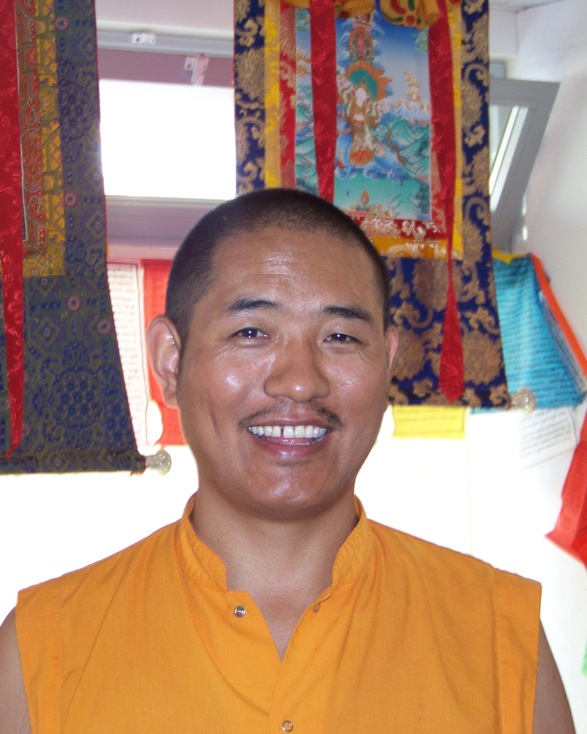
Venerable Drubpon Tsering Rinpoche is the resident Lama of the Drikung Garchen
Institute of the Drikung Kagyu School of Tibetan Buddhism.
Drubpon Tsering Rinpoche received
countless Abhishekas, pith instructions, and transmissions from H.E. Garchen
Rinpoche, including the empowerments of the eight Herukas, the fifty
empowerments of the Drikung Kagyü, of Chakrasamvara, Vajrayogini and the
collections of Chöd practices, as well as the Rigtä of all Dharma protectors of
the old and new transmissions. Khenpo Jigme Phuntshok bestowed on him the
Abhisheka of Kalachakra.
Rinpoche also obtained instructions from Payül
Khenpo Tenzin on the following scriptures: Bodhicharyavatara, the Thirty Seven
Practices of Bodhisattva, the Three Vows, and the Fifty Stanzas on the
Spiritual Teacher. From Khenpo Yeshe of the Nyingmapas, he received the Ngag
Chung Transmission (only by hearing), and instructions on the Aspiration Prayer
of Ground, Path and Result. Under Khenpo Urgyen Rinpoche he studied Gampopas
Jewel Ornament of Liberation, the Single Intent “Gong chig,” as well as Tibetan
Grammar. In a hundred-day-retreat, Rinpoche practiced the Tonglen of the Six
Realms, based on Patrul Rinpoche’s "Words of my perfect teacher." Tsering
Rinpoche also received his Bodhisattva vow, instructions on the Aspiration
Prayer of Sukhavati, the Nyingma Phowa and on Dzogchen Tregchöd, Thögal, Yeshe
Lama, along with the practice of Khor-de-Rü-shen, and the Rigpätsäl empowerment
from Khenpo Münsel. During his training, Rinpoche completed many retreats during
which he practiced the long Sadhanas of Vajrakilaya, Yamantaka, Guru Drakpo,
Vajrasattva, Ambithaba and White Tara, as well as Chöd, and one hundred sets of
Nyungne. Furthermore, Ven. Tsering Rinpoche followed a traditional Three-Year,
Three-Months and Three-Days Retreat, practicing the Fivefold Mahamudra known as
“Chagchen Ngaden”, and the Six Yogas of Naropa, whose instructions he received
from Lho Bongtrul Tenzin Nyinma.
In the year 2000, the year of the snake,
Rinpoche received all Abhishekas and transmission of the Drikung Kagyü tradition
from H.H. Drikung Kyabgön Chetsang in Dehradun, India. During the year of the
monkey, in 2004, both H.H. Kyabgön Chetsang Rinpoche and H.E. Garchen Rinpoche
conferred on him the title of Drubpon “Retreat Master.” In 2003, by the request
of H.E. Garchen Rinpoche, Drupon Tsering Rinpoche became the Lama in residence
at the Drikung Garchen Institute in Munich, where he represents H.E. Garchen
Rinpoche in the whole of Europe.
HE Garchen Rinpoche said,
“As
I have passed on all responsibilities to him, I believe that he will become an
authentic guide in terms of the true Dharma. As Lama Tsering has been with me
from the age of eight until now, [I recognize] his wish and experience to bring
benefit to others according to [the diverse kinds of] phenomena and
individuals.”
Drubpon Tsering Rinpoche share his vast knowledge, wisdom and compassion
selflessly with his infinite energy and patience to all.
Vördade Drubpon Tsering Rinpoche leder sedan 2003 Drikung
Garchen Institute i München inom Drikung Kagyu-traditionen i tibetansk Buddhism.
När Rinpoche var bara åtta år sökte han tillflykt hos Hans Eminens Garchen
Rinpoche. Tre år senare blev han ordinerad munk. Rinpoche mottog sin
munk-ordination, avlade Bodhisattva-löftet inför och fick
Mahamudra-instruktioner från den store Siddha Karma Norbu från Karma
Kagyu-traditionen. Från 11 års ålder utövade och studerade Rinpoche under
ledning av H.E. Garchen Rinpoche vid Gar kloster i Nangchen i östra Tibet, där
han fullföljde de förberedande utövningarna av Drikung Dzogchen Yangzab och
Longchen Nyingthig-traditionen. På Gar kloster tjänstgjorde Tsering Rinpoche som
shrine master i fem år (och senare som chant master) och utförde många
ceremonier, ritualer och Drubchen med H.E. Garchen Rinpoche. Rinpoche mottog
många undervisningar och initieringar från många mästare såsom H.E. Garchen
Rinpoche, Khenpo Jigme Phuntshok, Payül Khenpo Tenzin, Khenpo Yeshe, Khenpo
Urgyen Rinpoche, Khenpo Münsel, Lho Bongtrul Tenzin Nyinma och Hans Helighet
Drikung Kyabgön Chetsang Rinpoche. Under denna tid har Rinpoche fullföljt många
korta retreater. Han har dessutom gjort flera långa retreater inklusive den
traditionella treårs-retreaten.
2004 blev Rinpoche förlänad titeln Drubpon
(retreatmästare) av Hans Helighet Chetsang Rinpoche och Hans Eminens Garchen
Rinpoche. Sedan 2003 har Rinpoche lett Drikung Garchen Institute i München och
är utsedd som Hans Eminens Garchen Rinpoches representant i Europa. Vi är
väldigt hedrade att kunna motta undervisning av en så stor mästare som Drubpon
Tsering Rinpoche.
His Eminence Dagpo Chenga Rinpoche TOP
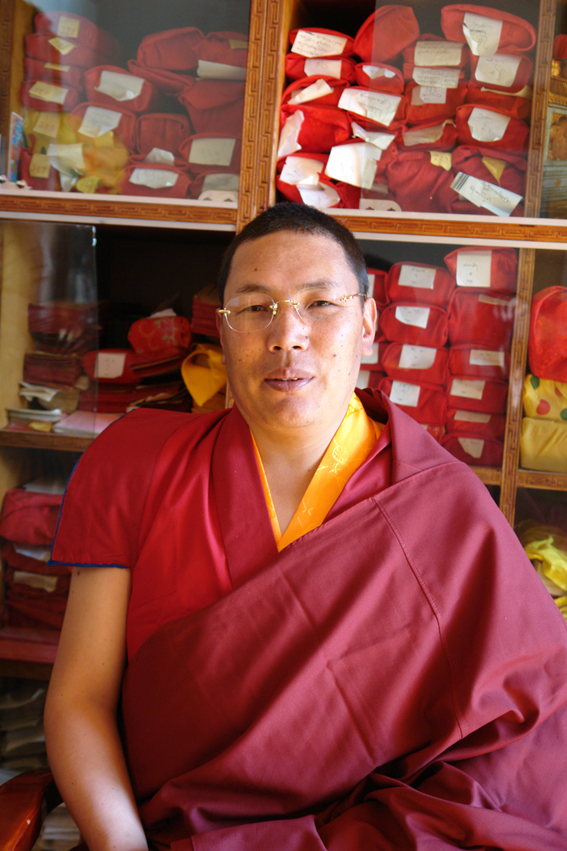 |
His Eminence Dagpo Chenga Rinpoche (Rase Konchok Gyatso
Rinpoche)
His Eminence Dagpo Chenga Rinpoche was recognized
as the 8th incarnation of Dagpo Chenga (the heart-disciple
of Gampopa (1079 – 1153)) and carries the Tulku-name Konchok Tenzin Thrinle
Lhündrup. Many of his books were published under the name Rase Konchok Gyatso.
His Eminence Dagpo Chenga Rinpoche was born in
1968 in the village below the monastery of Drikung Thel in Tibet. At young age,
he revealed a virtuous personality as well as a sharp mind. In 1981, Drubwang
Pachung Rinpoche (1901-1988) advised him to become a monk, gave him important
teachings, and instructed him to study and practice The Four Dharmas of
Gampopa and the Six Yogas of Naropa. Since then he studied under many
great teachers.
His Eminence Dagpo Chenga Rinpoche studied at
Drikung Buddhist College and at the Tibetan College in Lhasa. He also attended
the Medical and Astrological College. He studied the Ten Aspects of Knowledge,
as well as natural sciences, social sciences, and history. He became a scholar
proficient in all fields and is recognized as one of the most erudite master in
the Drikung Kagyü lineage.
Already as a young student, His Eminence Dagpo
Chenga Rinpoche began writing papers on many subjects of Tibetan history and
Tibetan Buddhism under the name Rase Konchok Gyatso. Among his books are The
History of the Yangrigar Monastery, The Main Seat of Pagdru Kagyü,
The Benefit of Being Vegetarian, and A Faithful Speech, which shows
how to develop, improve and spread the Drikung Kagyü Dharma traditions in the
future. He also wrote a book entitled The Mothers in the Land of Snows,
about famous women in the history of Tibet.
In 2004 a great thangka painting master, Penpa
Tsering’s famous disciple, Amdo Jampa, painted a series of sophisticated
thangkas portraying the Drikung Kagyü lineage holders, as well as The
Fivefold Path of Mahāmudrā thangka, The Twenty-Five Main Disciples of
Milarepa, and The Eight Types of Incarnations of Kyobpa Jigten Sumgon.
All the drawings were made in accordance with Dagpo Chenga's meticulous
commentary on the iconography.
His most important publication is The History
of Drikung ('bri gung chos' byung), which was published in 2004. In 2007, he
published The Ornament of Gongchig, a praise of the famous Gongchig
teachings of Kyobpa Jigten Sumgon (1143-1217) bestowed upon his disciple Chenga
Sherab Jungne (1187-1241), as well as a refutation of criticisms brought forward
against the Gongchig. In addition, he authored several short texts on
Lord Jigten Sumgon, Achi Chokyi Dolma, Angon Rinpoche, the history of Drikung
Thel Monastery, and an introduction to the Drikung sky burial ground (Durto
Tenchag), and a booklet on the holy places in the Drikung area.
Rase Konchok Gyatso also published some texts on
Buddhist studies, among them are the commentaries on the Fivefold Path of
Mahāmudrā and the Essence of the Three Vows (sdom pa gsum).
He compiled the daily rituals of Drikung in two volumes and authored many
articles about special Drikung teachings, including a Phowa text of the Drikung
tradition called The Color of the Rainbow.
To rescue the most important works on the Drikung
Kagyü lineage, for nearly a decade, Rase Konchok Gyatso has collaborated with
His Eminence Drikung Angon Rinpocche and some monks from the Drikung Thel
Monastery, gathering, combining and editing. The Great Treasury of Drikung
Kagyü has now reached 150 volumes. Under the organization of Balok Rinpoche,
Drikung Kagyü Marpa Translation Center is currently translating these sacred
articles into Chinese and English.
At the request of His Holiness Chungtsang
Rinpoche, Rase Konchok Gyatso is currently composing
A Comprehensive Explanation of the Thirteen Major Subjects (gzhung
chen bcu gsum) covering the thirteen major root texts of the Buddhist philosophy
such as Vinaya, the bodhisattva trainings, Maitreya's five treatises,
Abhidharma, Madhyamaka, and so on.
His Eminence Dagpo Chenga’s writings are same as
his oral teachings, namely, very precise, direct, and clear. They stand out with
very profound view and excellent knowledge. He continues to exert tireless
effort writing texts in order to benefit Buddhism in general and the Drikung
Kagyü lineage in particular.
Venerable Drubpon Kunsang Rinpoche TOP
|
|
|
Drubpon Kunsang Rinpoche was born in Ngari at the vicinity of Mt. Kailash in Tibet 1976. When he was six years old, he became monk and studied Dharma, rituals, prayers and so forth. As a little boy, he left Tibet to India and there he grew up. In Dharamsala , he studied mandala and thanka painting. Then in the Drikung Monastery, he studied philosophy for seven years. Afterwards he went into a three-year retreat in Amora, India completed the "Six Yogas of Naropa" and the "Five-Fold Path of Mahamudra. He received the award "Champion of the retreat." His main teacher H.H. Chetsang Rinpoche sent him to Nepal for another retreat for four years. Under the direction of His Holiness Dalai Lama, a group of representatives from all different religions came together and met with the scientists to discuss and exchange. Drubpon Kunsang Rinpoche was sent by the Tibetan Government in Dharamsala, India to Switzerland to take part in the project “Science Meets Dharma”. From 2001 to 2005, he studied natural sciences and training in intercultural relations in the Tibet Institute in Rikon in Switzerland. During that time, he met many people from Switzerland who were interested in the Dharma. H.E. Garchen Rinpoche encouraged him to start a center in Switzerland to teach the Dhamra. In 2005, the Drikung Kagyu Ling Dorje center with Drubpon Kunsang Rinpoche as chief lama was inaugurated by his Eminence Garchen Rinpoche with the blessing of His Holiness Chetsang Rinpoche. |
Venerable Khenchen Nyima Gyaltsen Rinpoche TOP
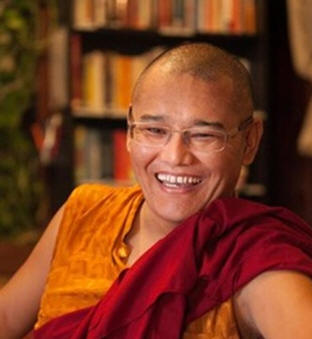 |
Khenchen Nyima Gyaltshen
Rinpoche was born in 1976. When he was nine, he received refuge vows
from Kyabje Ontrul Rinpoche. At 12, he joined the Lho Lungkar Monastery
in Kham, Tibet where he studied under monastery’s senior lamas Gongyam
and Drugsing. At 18, he came to JangChubLing Monastery in Dehra Dun,
India where he took the novice monk vows from His Holiness Chetsang
Rinpoche and studied for two years on the Essence of the Mahayana
Teachings and the Single Intention under Khenchen Konchog Gyaltshen
Rinpoche as well as major scriptures with the Khenpos and teachers
there. Then he joined the Dzongsar College in Bihar to further study the
major scriptures for seven years. In 1998, he received full monk’s
ordination from Mewa Khenchen Thubten Ozer Rinpoche. Then he received
oral transmission of the precious Kangyur of the Buddha from Choje
Togden Rinpoche as well as the pig, snake and monkey year teachings from
His Holiness Chetsang Rinpoche.
In 2002, His Holiness Chetsang Rinpoche authorized and instructed him to teach at the Kagyu College in JangChubLing. In 2004 during the Snake Year Teachings at Lumbini, he was enthroned as the Shedra Khenpo of the Drikung Kagyu College. Then, in 2006, Khenpo returned to Lho Lungkar Monastery to teach the monks and nuns of the monastic college and Jamyang Gatsel Ling Gampopa's Jewel Ornament of Liberation. Rinpoche has since 2005 been continuously residing and teaching at the Kagyu College sincerely and at the same time responsible for compiling texts, as well as assisting western translators. In October 2013, he received the title Khenpo Thripa (the one who takes charge of all the monasteries in exile) by His Holiness Chetsang Rinpoche. Khenchen Nyima Gyaltshen Rinpoche is an outstanding scholar of the Drikung tradition and has great ability to communicate complex and profound teachings in a readily comprehensible manner. All his students appreciate very much his sincere and clear teachings, his care and compassion towards each student’s need. |
Venerable Khenpo Konchok Tamphel TOP
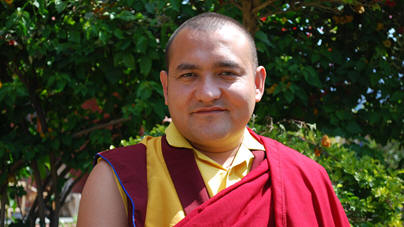 |
Venerable Khenpo Tamphel was born in 1975 in
Ladakh, India. At age nine, he became a monk at Lamayuru Monastery, one
of the three main Drikung Kagu monasteries in Ladakh. After completing
his basic monastic education, he joined the Drikung Kagyu Institute in
Dehra Dun in 1987 where he studied the various branches of Buddhist
philosophy for nine years and received the degree of Acharya in 1997.
Since then he has served as a translator for His Holiness Chetsang
Rinpoche and His Eminence Garchen Rinpoche, taught and worked as a
research officer at the Songtsen Library (an important institution and
resource for Buddhist Studies), taught at various Drikung Kagyu Dharma
Centers worldwide, translated and published rare Drikung Kagyu texts
from Tibetan to English. His translated works includes Water Crystal
(based on a commentary of the Ganges Mahamudra by H.H. Chetsang
Rinpoche), Introduction to Mahamudra the Co-emergent Unification
by Lord Jigten Sumgön and Shamatha to Mahamudra by Yongzin Ngedon
Gyatso. He earned his Khenpo degree in 2004. Since 2012, he has been
heading the Ratnasri Translation Group for 84000 Dharma Translation.
Since 2013, he has been teaching and assisting on research projects at
the University of Vienna where he has worked as a researcher in the past
project “Neue Erwägungen zur Buddha-Natur” (new considerations on Buddha
nature) between Oct. 2015 and Sept. 2018. |
Venerable Khenpo Konchok Choskyab TOP
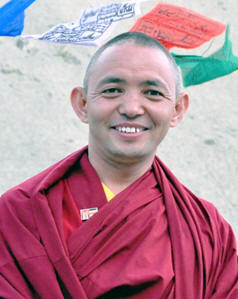 |
Khenpo Konchok Choskyab was born in 1977 in the village Umla in Ladakh.
He took novice vows in Phyang Monastery when he was eleven years old.
Together with Khenpo Rangdol and Khenpo Tamphel, he belonged to the
first group of monks who studied Buddhist philosophy in the newly
founded Drikung Kagyu Institute in Dehradun, in 1987. After nine years
of study at the Drikung Kagyu Institute, with the support of His
Holiness, he furthered his studies at the Sakya Dzongsar Institute for
three more years. Then, he taught the monks and nuns at the Drikung
Kagyu Institute and Samtenling nunnery. He jointly revised the
collective work of Dharmakirti (Kunkhyen Rigzin Chödrak, 1595-1659) with
His Eminence Nubpa Rinpoche, as well as the writings of Kyobpa Jigten
Sumgon with His Holiness the Drikung Kyabgon Chetsang. During the Snake
Year Winter Teachings in 2000/2001 he received the complete
transmissions of the Drikung Kagyu tradition. During a two months stay
in Bhutan he received teachings and transmissions from His Eminence Je
Khenpo Rinpoche on Chakrasamvara (Khorlo Demchog). Subsequently he
studied Buddhist logic, the Prajnaparamita sutras as well as the
teachings of Madyamika philosophy with Je Rinpoche at Drepung Loseling
Monastery in South India for another nine years. In 2009 he was made a
Khenpo by His Holiness the Drikung Kyabgon Chetsang. At present, he is
the Abbot of the Kagyu College. |
Venerable Khenmo Konchog Nyima Drolma TOP
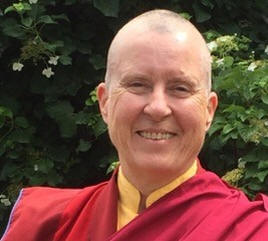 |
Khenmo was an esteemed Professor of Sculpture at the University of
Maine and at the Maine College of Art in Portland, ME before becoming a
Buddhist nun. Throughout her distinguished academic career, she received
numerous awards and prizes for her work. She has a MFA from the
University of Pennsylvania and 20 years of teaching experience at a
college level. She is a breast cancer survivor, who served as an Art
Fellow at the Connecticut Hospice and board member of the Addison
Respite Care Home in Vermont and Maine Respite Home where she started an
arts team for hospice volunteers. After studying Buddhism for 15 years, in 1995 she made a pilgrimage to India, residing at Namgyal Monastery studying Tibetan, Lam Rim texts and sand mandalas at the Tibetan Library of Works and Archives initially for 3 months. returning again the following year for another 5 months. In 1997 she took Novice ordination with HH Chetsang Rinpoche. She then received the many cycles of Drikung empowerments and lungs over a period of many annual trips to India. She also began her retreat training with a 5 month solitary retreat in the mountains of Almora, India at the Drikung three year retreat center. This retreat practice became a way of life with annual solitary retreats. In 1999 she entered intensive monastic training at Gampo Abbey in Nova Scotia; learning the monastic rituals and duties. There she studied with Ven. Pema Chödrön. She spent the next two years in shedra studying Buddhist classics of philosophy including the Abhidharmakosa, Dudra, Lorig, Tarig The Bodhisattva’s Way of Life, the Uttara Tantra, Tenet systems, classical Tibetan and debate. While there she created a bronze statue of Gampopa for the Abbey Stupa and directed monastic training. She then supervised the building of a Peace stupa in Vermont. In 2002 Khenpo Drolma was invited to come to India to fulfill the vision of HH Chetsang Rinpoche, to make a statue of King Songtsen Gonpo based on a dream of the 10 th Panchen Lama. This statue originally was to have been installed in the main square of Lhasa, Tibet; but due to the invasion of China all plans were abandoned. She became the Art Director for the creation of all the art works for Songtsen Library. To actualize H.H. Chetsang Rinpoche’s artistic vision, Khenpo Drolma led an international team of 16 artists in creating 40-ceiling thangkas, an elaborate two story entry door and numerous statues using traditional Tibetan techniques and materials dating back to the 1500’s. Khenpo Drolma, aware of the significance of the statue and importance of historical accuracy of the depiction of King Songtsen Gampo researched details in the great libraries of India to document 7th century fabric, clothing, jewelry and horse harnesses. HH Chetsang Rinpoche encouraged Khenmo to take full ordination as a bhiksunni in Taiwan at the Ji Yu Chen Monastery, becoming the first fully ordained nun in the Drikung Lineage. Khenmo returned to the US to begin working on establishing Vajra Dakini Nunnery. In 2004 during the Drikung Monkey Year Teachings in Lumbini, Nepal she was installed as a Khenmo in the Drikung lineage, becoming the first westerner to hold the responsibility of abbot. Since then she has worked continuously to establish Vajra Dakini Nunnery and teach the Dharma internationally. |
His Eminence Choje Togdan Rinpoche TOP
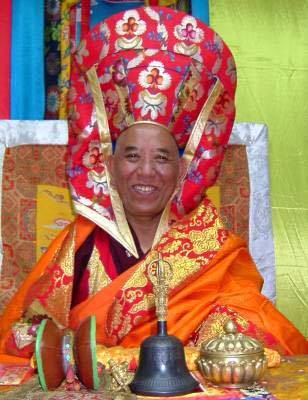 |
His Eminence Choje Togdan Rinpoche is the Choje (Dharma
Master), the spiritual leader of the Drikung Kagyu Tradition in Ladakh.
The title Togdan means “endowed with realization”. Chojes were sent from
Drikung Thil Monastery in Tibet to places such as Mt. Kailash, Tsari,
Lapchi, and Ladakh. Since the previous incarnation of Togdan Rinpoche
was from Ladakh, it became a tradition that his successive
reincarnations would be appointed as the Chojes for Ladakh. Rinpoche is the successive incarnations of the
Indian Mahasiddha Hungchen Kara (Hungkara), (one of the Eight Great
Vidyadharas), who centuries later incarnated as the Kongbo Togdan Tulku,
a disciple of the 17th Drikung lineage holder Rinchen Phuntsog
(1509-1557). The following seven reincarnations were born in Tibet and
the 8th in Ladakh. Rinpoche is also recognized as the manifestation of
Nyang Tingdzin Zangpo, the Tibetan minister of religion in the 8th
century, and a key figure in the establishment of Buddhism in Tibet.
Nyang Tingdzin Zangpo was the first abbot of Samye Monastery, the heart
disciple of the great guru Vimalamitra and have been credited for
suggesting the king to invite Padmasambhava to Tibet. He was one of the
few masters in history said to have attained the rainbow body, the
highest achievement of Tibetan Buddhism’s Dzogchen practice. The present Togdan with his religious name Konchog
Tenzin Thubten Tenpe Gyaltsen it the 9th reincarnation. He was born into
the poor family of Konchog Tsultrim and Kelsang Dolma in 1939 in Durbuk,
a small village situated 110 km from Leh in Changthang. At the age of
two years he lost his mother and was taken care of by his aunt. At the
time of his mother’s death, the family goat gave birth to new offspring
and Rinpoche could drink its milk. When he was one and a half years old
he left a footprint on a bolder. Several miraculous happenings around
his birth and afterwards clearly revealed his superior qualities. The previous Kyabgon Chetsang Rinpoche, Shiwe Lodro
(1886-1943) recognized the young boy as the incarnation of Togdan Tulku
when he was only 18 months old. In 1943 he was enthroned as Choje Togdan
Rinpoche in Sharchukhul Monastery, which is one of the three major
monasteries of the Drikung sect in Ladakh. The monastery is located very
close to his birthplace. He received the traditional education at a very
young age. In 1951 he accompanied by his tutor Gegen Sonam, the young
Rinpoche traveled through Sikkim over three weeks on horseback on his
way to Drikung Thil Monastery in Tibet. There he started his training,
receiving teachings from renown spiritual masters and completing many
retreats. Till 1954 he studied in the Drikung Nyima Changra College for
higher Buddhist studies. When China took over Tibet in 1959 he came back
to Ladakh along with his tutor and many Ladakhi monks. Since then
Rinpoche carried out his responsibilities for fifty Drikung monasteries
in Ladakh while maintaining the Drikung Kagyu tradition there. Rinpoche holds special Drikung Kagyu transmissions
of Gongchig, Yamantaka, Phowa and Dharmapalas. He also holds the
transmission of the Rinchen Terdzo. In 1960s, he met his root guru H.H.
Dudjom Rinpoche in Kalimpong and in the beginning of 1967, Rinpoche
arranged a great transmission of Rinchen Terdzod by Dudjom Rinpoche to
be given at Tso Pema, Rewalsar, one of the most sacred places of Guru
Rinpoche. H.H. Dudjom Rinpoche gave this empowerment to a large assembly
of thirty Tulkus and several thousand people. Subsequently Dudjom
Rinpoche initiated Togdan Rinpoche as his successor for imparting this
great empowerment of Rinchen Terdzo. Years later Rinpoche discovered several sacred
“hidden places” and also revealed some mind treasure text (dgongs gter)
His collected works comprising one volume include a short commentary on
the Gongchig. In the 1960s Rinpoche was the only spiritual leader
of the Drikungpa school who held all kinds of oral and empowerment
transmissions of the Drikung tradition. Therefore he gave several
empowerments and oral transmissions to the Drikungpas living in India
and abroad, including His Holiness Drikung Chetsang Rinpoche, whom he
gave the oral transmission of Rigzin Chodrak’s (1595-1659) work. In 1974 Togdan Rinpoche invited Kyunga Rinpoche
(1911-1980) to Ladakh, where he started a meditation center at Chushul.
Later this meditation center was moved to Lamayuru. After repairing the
monastery of Atitse in 1981, Rinpoche established a school for young
monks there. Atitse monastery is situated northwest of Lamayuru. In 1978, under the supervision of Togdan Rinpoche a
grand reception ceremony was held at Leh for His Holiness the Drikung
Kyabgon Chetsang Rinpoche, after his escape from Tibet and his return
from the USA. Since then it was for the first time that Chetsang
Rinpoche and Togdan Rinpoche worked together for strengthening the
Drikung Kagyu in Ladakh. In 1979, under both the spiritual leaders, the
800th anniversary of the founding of Drikung Thil Monastery was
celebrated at Phyang Monastery. Togdan Rinpoche was the president of Gompa
Association from 1972 to 1975. During this period he attended
international Buddhist conferences held in Taiwan, Spain, Germany,
Switzerland and France. In 1979 H.H. Kyabgon Chetsang Rinpoche and Togdan
Rinpoche hosted a marvellous celebration for the 800th year anniversary
of founding of the Drikung Thil monastery by Lord Jigten Sumgon, the
founder of the Drikung lineage. In 1985 Rinpoche hosted a historic meeting of three
religious leaders of the Drikung lineage between H.H. Kyabgon Chetsang,
H.H. Kyabgon Chungtsang and himself. Continuing the heritage of
Drikungpa as a force for dharma propagation in Ladakh. In 1981 Rinpoche built new temples such as Zang
Dogparli and repaired many old monasteries, including the historical
Atishe Monastery which houses an actual meditation chamber of Naropa Social activities Since 1959 Togdan Rinpoche has undertaken various
religious as well as social welfare activities in Ladakh and became a
popular leader. He worked tirelessly for raising the consciousness among
the Ladakhi populace for the need of good education, succeeding in
sending many students to Srinagar and Jammu. The main task for Togdan
Rinpoche after his return from Tibet was to reorganize the approximately
50 various Drikung monasteries of Ladakh. During the Snake year teachings in 2000 and 2001 at
Drikung Kagyu Institute, Dehra Dun, he gave several precious oral
transmissions. From 12th December 2002 until 19th February 2003, the
18th day of the last month of the Tibetan calendar, which happens to be
an important auspicious day for Drikungpas, he bestowed the oral
transmission of 101 volumes of Buddha’s precepts in the auspicious
presence of H.H. Drikung Kyabgon Chetsang Rinpoche, Taklung Shabdrung
Rinpoche, other Tulkus and Khenpos and an assembly of more than 400
monks, nuns, and lay people. Political activities In 1967 H.E. Togdan Rinpoche was elected as the
chairman of the Ladakh Action Committee, furthering the demands of
Ladakh with regard to the Indian government. Under his leadership the
Committee was able to get ten demands accepted by the government. Thus
Togdan Rinpoche became also a known political leader. For four years
Togdan Rinpoche was also appointed as vice-chairman of the Ladakh
Development Board. During this period several developmental schemes were
executed in far-off places in Ladakh. Among the most prominent
achievements were Durbuk canal, Alchi bridge, high schools and many
lower schools, Medical Aid Centers at Temisgam, Sumoor, Man-Merak and
Skurbuchen. Togdan Rinpoche became also president of the
National Conference Party, Leh, and he was nominated as MLC (Member of
Legislative Council) in the Jammu and Kashmir Assembly and later
elevated to Minister of State for Ladakh Affairs and Planning in the
cabinet of Honorable Chief Minister, Dr. Farooq Abdullah. As Minister of
State for Ladakh Affairs and Planning, Togdan Rinpoche has taken various
steps for a speedier development of Ladakh. He successfully tried his
best to enhance budgetary grants for the region of Ladakh. He projected
plans for the construction of an air strip in the remote Zanskar region
and the Nimoo-Basgo hydroelectric plant. He also proposed to open the
Kailash-Mansarovar road for pilgrims (Kailash Yatra), but unfortunately
no action came forward until present. In September 2002 Togdan Rinpoche resigned from his
post as Minister of State for Ladakh Affairs and Planning, which he had
held for six years. However, his selfless services still continue for
the people of Ladakh and Tibetan society in particular and all living
beings in general with his genuine dedication towards the Dharma. Today Today, Rinpoche’s live achievements make him a
model example for the dharma practitioner of the modern times; attaining
excellence in both worldly and spiritual life. Rinpoche has been
referenced to in many popular books and have appeared in two documentary
films about Tibetan Buddhism. Rinpoche’s complete name is H.E. 9th Choje Togdan
Rinpoche, Terton Rigched Dorje, Konchog Tenzin Thupthen Tenpei Gyaltsen
and he is the Drikung Dharma Lord (Choje) of Ladakh. He and his lovely
wife Lha-cham have raised a dharma family of two sons and three
daughters. In a long-life prayer to Rinpoche, H.H Dudjom
Rinpoche wrote that: “he is the northern heavenly king and the bestower
of glory…the river of nectar of the Nyingmapa tradition…the Bodhisattva
akin to the youthful moon leading countless star constellations…the
Vidyadhara of Long Life.” In the current 9th incarnation of Togdan Rinpoche,
is also included the manifestation of Rigzin Jatson Nyingpo.
A great terton master who spent 17 years in a sealed hermitage
retreat and was the root guru of such renown masters as Kathog Dudul
Dorje, Lhatsun Chenpo, 10th Karmapa, 1st Drikung Chungtsang, 5th
Drugchen and many others during the 16th century. Having been recognized by the 36th H.H. Kyabgon
Chetsang as the 9th Togdan Rinpoche, Rinpoche was given the leadership
of the unbroken Drikung tradition in Ladakh. This included the
responsibility for over 50 monasteries and the cultivation of the
Drikung tradition in the region. His Eminence Choje Togdan Rinpoche appears in two documentary films below: Yogis Of Tibet - Documentary - The Truth in The
Dharma (https://www.youtube.com/watch?v=XGKy2pN_d4k)
– in this YouTube film (starting at 46:56 ), H.E. Togdan Rinpoche
describes his childhood vision of Guru Padmasambhava when he also made a
foot imprint in the solid rock at the site of the vision. The Tibetan Book of the Dead A Way of Life (https://www.youtube.com/watch?v=0gloEua0RSs)
– this YouTube film (starting at 12:55) shows how H.E. Togdan Rinpoche
serves his Buddhist communities in Ladakh and how he performed Phowa
(consciousness transference ritual) for a deceased villager.
|
The Late Venerable Drikung Lamchen Gyalpo Rinpoche (1938 - Oct. 15, 2017)TOP
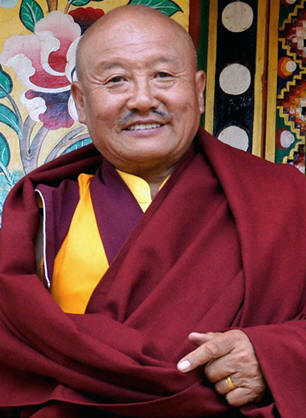 |
LAMCHEN GYALPO RINPOCHE is recognized as an extraordinary scholar and
practitioner possessing great realization of both Dzogchen and
Mahamudra. He is uniquely qualified to transmit the Drikung Dzogchen
teachings. He has studied extensively with some of the greatest masters
of Tibetan Buddhism.
Rinpoche has received complete teachings from the generative stages to the completion stages of Yamantaka, Chakrasamvara, and Vajravarahi, among other practices, from many enlightened masters of the Drikung Kagyu Lineage. Gyalpo Rinpoche went on retreats with his masters and received core teachings on Mahamudra, and the transfer of profound experiential insight by the Drikung Master, Gelong Pachung Rinpoche and Drubwang Kyunga Rinpoche. From His Holiness the 16th Karmapa, Gyalpo Rinpoche received such profound teachings as Mahamudra, and Karmapa Rangjung Dorje's Tsig-chigma; from Situ Pema Wangchog, Abishekas, commentaries and experiential insight; from Zigar Kongtul Rinpoche, Rinchen Terzo and Abishekas, commentaries, and transfer of experiential insight on all Yidam deities; from Ripa Seljey Rinpoche, Karma Kagyu empowerments and teachings; and from Dilgo Khentse Rinpoche, Nyingmapa tantras, sadhanas, and experiential insight in general and Nyingthig Yabshi teachings in particular. Gyalpo Rinpoche received from other such enlightened masters as Poli Khenchen Dorjechang, Nyoshul Khenpo Jampal Dorje and Khenpo Thubten Rinpoche numerous aspects of Dzogchen empowerments, teachings, and conveyance of experiential insights with special emphasis on Longchen Nyingthig. From former Drugpa Chogon, Drugchen Thamche Kyenpa, and Yoge Rigzin Gyalpo Rinpoche received thorough introduction to the very essence of Mahamudra and the Great Perfection and Drugpa teachings with special emphasis on Doha. From his root guru, Khunu Rinpoche Tenzin Gyaltsen - the lifeline of all Buddhist traditions - Gyalpo Rinpoche received profound teachings on the core of Mahamudra and the Great Perfection with special emphasis on tregchod and thogal. The teachings of such profound masters were practiced from the Preliminary to the stages of Arising and Completion, punctuated with retreats and propitiation of deities which included three Major retreats and Yidam Propitiations. Lamchen Gyalpo Rinpoche was reborn into an aristocratic family in Tibet and is the incarnation of Lhama Phurga. After his escape from Tibet, he served in the Tibetan Parliament for 11 years as Senior Secretary to the Kashag in Dharamsala nd later as Executive Manager of Tibetan Self-Help Handicraft Center in Simla, India. His Holiness Drikung Kyabgon Chetsang convinced him to follow His Holiness to Dehra Dun.There he served as his Private Secretary and General Secretary of Drikung Kagyu Institute (Jangchubling) during the time of founding and registering of the Institute and contributed tiredlessly throughout the various stages of the building the seat of the Drikung Kagyu Tradition in exile that stands today. "The holder of the dharma's lifeline with the word 'Gyal' in his name refered to Gyalpo Rinpoche's contribution to the rekindling of the Drikung Kagyu Tradition in exile. In a successful effort to reach out to Lineage followers, Gyalpo Rinpoche toured every single Drikung monastery from the regions in Eastern Tibet to Mt. Kailash. He also assisted His Holiness the Drikung Kyabgon Rinpoche with the history of Drikung and other such writings and helped to hang on to the "dharma lifeline" at such difficult times as in the beginning. Gyalpo Rinpoche also created the basic conditions to enable the establishment of the Seat of Dorje Drag - the lifeline of Nyingmapa Tradition - in Simla as well. Rinpoche is throne holder of Ka Tashi Thubten Rabgye Ling Monastery and is their reincarnate lama. "Presenting himself in many appearances" Gyalpo Rinpoche was a regional lord/administrator, he is also a Tulku, a monk, was a bureaucrat, a scholar and a lama in different aspects while dwelling in the same unchanging essence. Later he established several Dharma centers in the United States and Taiwan. For the past years Rinpoche has been busy traveling around the world to share his extensive knowledge of the Dharma to his many students. Lamchen Gyalpo Rinpoche is one of the highest and most important lamas of the Drikung Kagyu tradition. He holds the pith oral instructions of precious Dharma teachings for many lineages. More on Rinpoche's biography |
The Late His Eminence Drubwang Konchok Norbu Rinpoche
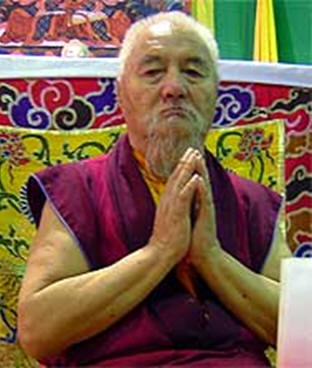
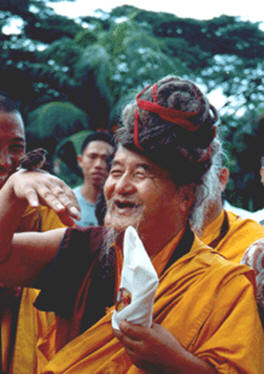
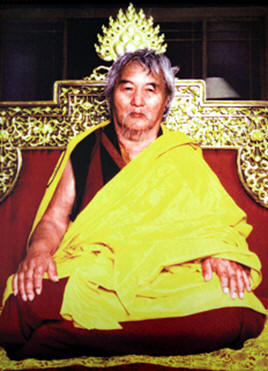
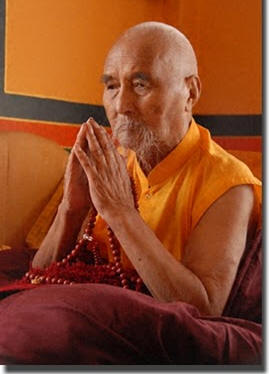
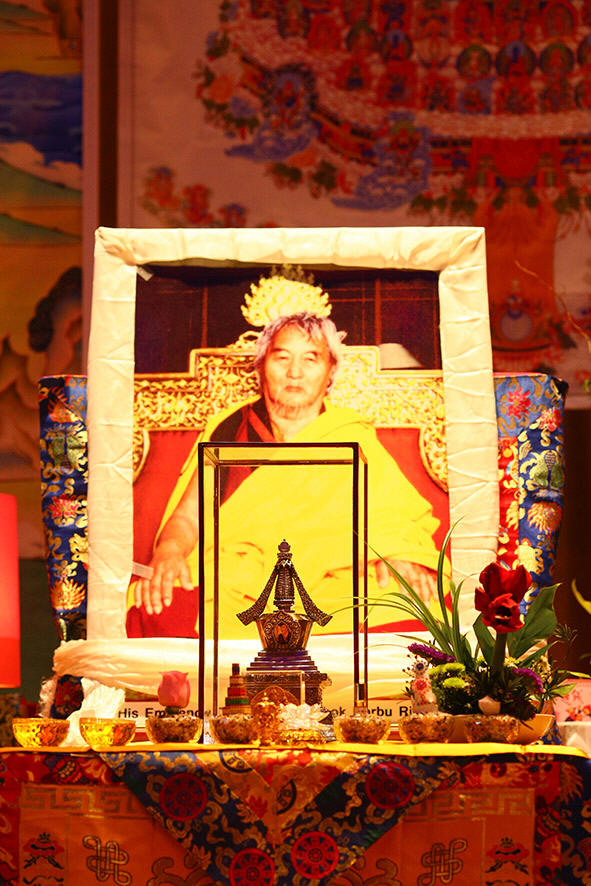
Biography of the
great accomplished Late His Eminence Drubwang Konchok Norbu Rinpoche (1921-2007)
"Life or death, to
me, is the same.
Light or darkness, to me, is the same.
Morning or night, to
me, is the same.
My mind is not the same like you, sentient
beings.
Although I may look like all of you externally,
Internally, I am not
like ordinary beings at all !!"
"I have realized the Mahamudra -- the ultimate Nature of Reality.
And the first person
whom i saw after i realized Mahamudra is His Holiness the Dalai Lama....."
He saw His Holiness
the Dalai Lama often in his vision. In the early 1991, after the passing of
Pachung Rinpoche at the advance age of seventy, he overcame great difficulties
and traveled all the way from Drikung Thil, Tibet to Jangchub Ling, Dehra Dun,
India to be with His Holiness Drikung Kyabgön Chetsang Rinpoche. He spent most
of his time in solitary retreat. When not at Jangchub Ling, Rinpoche travelled
in the remote areas of northern India teaching the locals (who are mostly of
Tibetan descent or have assimilated Tibetan Buddhism) the virtues of seemingly
simple but ultimately profound Dharma practices such as careful attention to the
law of cause and effect, sincere taking of refuge in the Three Jewels,
cultivation of compassion – especially by giving up the consumption of meat—and
complete reliance on the Six-syllable (Mani) Mantra.
In India, he met up
with His Holiness the 14th Dalai Lama who requested him to travel to different
places to give teachings for the benefit of all sentient beings.
"I have informed
His Holiness that I wanted to show nirvana. But His Holiness wants me to stay on
for the good of beings and Dharma. I cannot refuse His Holiness. His Holiness
told me that my "time has come to benefit others". Therefore, I have agreed to
stay in this world for about another 10 years or so. All these will depend on
karma and merit...... Everything then has happened exactly like what His
Holiness had told me. .... !!"
Drubwang Rinpoche's
compassion and kindness was so vast that he often donated everything he owned
(money and materials) to the sangha community for the welfare of the sangha or
Dharma propagation purposes. His Eminence was well known for his generosity.
Drubwang Konchok
Norbu Rinpoche did not give tantric Dzogchen nor lofty teachings on Mahamudra.
He encouraged and inspired people to do the simplest of all dharma practices: to
extend kindness to all sentient beings and to do the practice of the three kayas
by reciting:
Dharmakaya: OM AH MI
DEWA HRIH ( Heart Mantra of Amitabha)
Sambhogakaya: OM MA
NI PAD ME HUNG ( Heart Mantra of Chenrezig)
Nirmanakaya: OM AH
HUNG VARJRA GURU PADMA SIDDHI HUNG (Heart Mantra of Padmasambhava)
Some time ago
Drubwang Rinpoche forewarned that he would leave this world for the benefit of
all sentient beings. At the request of H.H. Dalai Lama, Drubwang Rinpoche agreed
to stay on for a few more years, and in September 1999, His Holiness wrote a
long life prayer for Rinpoche at the request of the Drikung Kyabgon Chetsang
Rinpoche, the Supreme Co-Head of the Drikung Kagyu Lineage of Tibetan Buddhism.
Drubwang Rinpoche
initiated the first Singapore 100 Million Mani Recitation Retreat in 2001.
Accumulation of the100 million Mani mantra was achieved. The retreat has since
become an annual dharma event in Singapore. On 25 December 2007, Drubwang
Rinpoche passed into parinirvana in Singapore. Rinpoche was remembered for his
genuine teachings and straight forward advices. His compassion and his effort in
propagating the six-syllable mantra have served as a great inspiration to many.
H.E.
Drubwang Konchok Norbu Rinpoche Encouraged Vegetarianism
Singapore -- In his
final years, the late great His Eminence Drubwang Konchok Norbu Rinpoche
repeatedly touched upon two teachings in his talks during the popular Mani
retreats that he held. The first is the urgency of upholding the Mani mantra (Om
Mani Padme Hung), and the second is the urgency of abstaining from eating meat.
Compassion is
important because it is seen as the root of all virtues in Buddhism. While
compassion has to balance with wisdom, it precedes wisdom in priority. Even the
seeking of wisdom for self-liberation is possible only when one has compassion
for oneself. Without the perfect compassion of the Buddhas, who aspire to guide
all beings to liberation, there would be no widely taught Dharma at all. Any
other virtue, when lacking in compassion, renders it a fault too. Thus is the
quality of compassion central and crucial.
Despite being born
in Tibet with scarce vegetation, Rinpoche was indeed
Today, with the wide
availability of more vegetarian options, Tibetan monasteries around the world
are increasingly going vegetarian. Even His Holiness the 14th Dalai Lama, the
spiritual leader of the international Tibetan Buddhist community, who once wrote
a long life prayer for Rinpoche, strongly advocates the vegetarian cause. This
is simply the way it has to be - for if even the leaders of Buddhism do not
encourage compassion for voiceless animals, the heart or core value that is
compassion would be lost. "Heart-less" then would Buddhist practice be - with
the hypocrisy of wishing all beings to be well and happy while wishing to eat
some of these beings. Vegetarianism is no must for all Buddhists, but surely, it
ought to be mindfully considered.
Teachings
by His Eminence Drubwang Konchok Norbu Rinpoche on 8 Dec 2003 at Than Hsiang
Temple, Penang, Malaysia during 100 Million Six-Syllable Mantra Recitation
Retreat (on Meat-Eating)
As practitioners of this precious Dharma, we
need to eradicate all non-virtuous deeds in general, particularly the
consumption of meat, as it has the heaviest negative karma. This is because all
the livings beings that we eat are actually our own parents who have been very
kind to us in many lifetimes. Eating meat is a non-virtuous act with such heavy
misgivings that the Buddha Himself also mentioned that consuming the meat of
other sentient beings who have been our parents one lifetime or another is the
gravest and most heinous deed to commit.
As Buddhists, we
practice to benefit oneself and others. Hence, we do the six-syllable (Om Mani
Pad Me Hung) mantra practice. However, when we eat meat - be it chicken, pork,
fish or eggs... in our daily lives, we are creating immense negative karma.
If on the one hand,
we chant the mantra and on the other hand, we eat the meat of another sentient
being, then our words and actions do not tally with one another. We are not
practicing as we preach. Can this be considered as loving-kindness and
compassion towards sentient beings? Is this doing good and abstaining from evil?
We take refuge in the Buddha because His teachings could benefit all sentient
beings. As Buddhists, we should understand the essence of the Buddha's wisdom
and teachings, which is to do good and abstain from committing evil deeds.
Abstaining from evil means that we have to keep our vinaya precepts. Hence we
should not take meat.
One of the greatest
obstacles to the birth of Bodhicittain our minds is our craving for meat.
When we are sick,
old or near death, we would go to a doctor - we would practice and do anything
possible and extend our life span. However, when we take meat, we are killing
sentient beings that are healthy. How great is our compassion and
loving-kindness if we treat sentient beings in such a manner? We should abstain
from killing because it generates immense negative karma. Instead, we should
develop loving-kindness and compassion towards all sentient beings.
There are some
people who say that their doctor has advised them against becoming vegetarians,
as they would suffer from malnutrition. [The truth is a balanced vegetarian diet
is much better than a non-vegetarian diet.] This is a sign that the
determination of these people is not strong enough. For if one has strong
determination, one would avoid doing evil deeds at all cost and under any
circumstances.
Hence in our daily
lives, we should stop committing the negative deed of eating meat. On this
basis, the merit generated from our refuge and practice of the six-syllable
mantra would be inconceivable. We should try to change our lifestyle towards
vegetarianism. We would certainly face difficulties in becoming vegetarians.
However, when such obstacles arise, we should remember how every sentient being
had at one point or another been our parents. When we remember this, then we
would not take meat just as we would not eat the meat of our parents of this
lifetime.
In countless
rebirths, all sentient beings have been our parents. When we took rebirth in the
human realm, we had human parents; when we took rebirth in the animal realm, we
had animal parents and so forth. Samsara is such. We need to generate a sense of
gratitude towards our parents in this lifetime and those of our past lives.
Hence, we should be vegetarians and abstain from taking meat. In such a way, we
would do good and give meaning to our practice. By doing so, our practice of the
six-syllable mantra would be able to benefit ourselves and others, and also aid
in the flourishing of the Dharma.
A few stories
about Drubwang Rinpoche
This story was told by Lama Samten. Some of the
Buddhist philosophical texts explain that when you reach certain levels of
realization you are able to perform miracles in order to train people who have
pride and jealously. You can heal people who are sick and so forth. Drubwang
Rinpoche had accomplished the highest state of meditative realization.
Occasionally he performed miracles in order to inspire the disciples of Lord
Buddha Shakyamuni - especially for Vajrayana practitioners, and in particular
for the Drikung Kagyu lineage.
The Drikung Kagyu
lineage specializes in meditation. Lord Jigten Sumgon prophesied again and
again, that "My lineage will continue to have the great realization yogis until
the end of the Lord Buddha’s teachings". Even though Tibet was invaded, there
are still many great Drikung Kagyu meditators, such as Pachung Rinpoche, Kungha
Rinpoche, Drubwang Rinpoche, Tenzin Nima Rinpoche and other great teachers.
Drubwang Rinpoche
stayed in many different places in India, including Dharmasala and Dehra Dun,
and every year he traveled to Ladakh in the summertime. Thousands of Chenrezig
mantras were accumulated due to Drubwang Rinpoche’s visits to these different
places. His Holiness the Dalai Lama was very pleased with Drubwang Rinpoche’s
accomplishment of meditation. His Holiness the Dalai Lama and Drubwang Rinpoche
did an Achi meditation retreat together.
One day Drubwang
Rinpoche traveled with a couple of his attendants to the district of Manali, and
visited some very remote places. One area he visited used to be a Buddhist
place, but because it was so remote and had lots of snowfall in the winter, over
time there were no longer any teachers or lamas available there to teach. It had
become place unknown to Buddhists. He found that there were still some ancient
temples walls, paintings and a prayer wheel there. However, the prayer wheel was
no longer turning and the doors were all closed up by a stone wall. There were
only these signs of the past Buddhist activities, but no longer were these
temples or sacred prayer wheels being maintained or taken care of. When Drubwang
Rinpoche arrived in this remote area, many people came to see him and receive
his blessings. He asked them to open up the blocked windows and doors to reveal
the old prayer wheel hidden inside. The people were very curious why he was
opening up this old prayer wheel. After they had done as he asked, and
everything had been cleared away, Drubwang Rinpoche sat down outside the doors
to the large prayer wheel and he began to meditate. The people there also joined
his meditation. After about 15 to 20 minutes, the prayer wheel began to
spontaneously turn. The people began to make prostrations and their devotion to
him began to increase. Drubwang Rinpoche stayed there for a couple of months and
gave many teachings and personal advice to the people there. During that time
the people were very devoted and made a lot of offerings to him. When it is was
time for Drubwang Rinpoche to leave that place, he left all the donations he had
received there to the people in order for them to restore the old monasteries
and ancient prayer wheel.
When Drubwang
Rinpoche visited Ladakh, many people came to see him. Sometime people who came
were very seriously ill. One man, Tsewang Dorje, who lived in Leh, was very sick
with liver problems. Tsewang Dorje had gone to Delhi for operation. The doctor
told him that he had only 3 weeks to live if he did not operate and even with
the operation, he would only have two months to live, and the operation was very
risky. Tsewang really could not afford the operation, and so he went back home
to Leh. Tsewang went to see Drubwang Rinpoche when Rinpoche came to Leh.
Drubwang Rinpoche told him that in his previous life, Tsewang had killed four
people and that was the cause of his current karmic situation. Drubwang Rinpoche
gave him blessings and a specific Dharma practice to do. Rinpoche told Tsewang
that after he was well, he must do volunteer work in the hospital and help many
people in order to completely overcome his current illness. Tsewang did as he
was instructed, and was completely healed.
This next story was
told by Lama Rigzen. When Drubwang Rinpoche was staying at Phyang monastery.
Phyang monastery is located near a large army camp . In Ladakh, the army is very
helpful to the monastery and local people financially and in other beneficial
ways. One day the monastery was visited by the Captain of the nearby army while
Drubwang Rinpoche was there. The Captain was very curious and asked Drubwang
Rinpoche about his long hair. Lama Rigzen answered that Drubwang Rinpoche was a
great, accomplished meditation master. The Captain said that his wife seemed to
be possessed by demons for the last two years. He had to hire someone to take
care of her, and watch over her all of the time. He had taken her to
psychologists, psychiatrists and so on, but no one had been able to help her.
Lama Rigzen suggested that the Captain bring his wife to see Drubwang Rinpoche.
The first time she came to visit Rinpoche, she was totally out of control,
crying and did not want to really see him at all. Drubwang Rinpoche yelled at
her face to face in Tibetan, not actually to her, but to what was within her,
saying "It is such a shame to harm others and you should leave this sentient
being alone. I am telling you to leave. If you do not listen, I will do
something and you will loose your freedom". Then Drubwang Rinpoche’s face turned
red, and he began to chant and pray. He continually blessed her by touching her
head with his prayer text until she fell unconscious. When she regained her
consciousness, she was totally a different person. The Captain brought her
several times to see Rinpoche, and each time she got a little better until she
was finally back to normal again. The Captain and his wife were very grateful to
Drubwang Rinpoche.
Sources:
https://www.dharma-media.org/ratnashripj/teacher_drubwang.html
http://maniretreat.sg/eminence-teachers/
http://www.shabkar.org/teachers/tibetanbuddhism/drubwang_konchok_norbu.htm
http://www.shabkar.org/download/pdf/Significance_and_Benefits_of_Six-Syllable_Mantra_Recitation.pdf
http://drikungtmc.com/resources/other-teachers/
https://www.buddhistchannel.tv/index.php?id=9,5668,0,0,1,0
http://thanhsiang.org/en/demise-his-eminence-drubwang-rinpoche-0
http://www.casotac.com/CASonline%20Articles/29122007.html
The Late Kyunga Konchok Zopa Gyatso Rinpoche
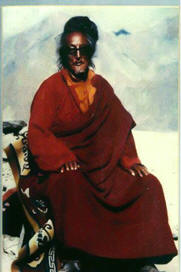
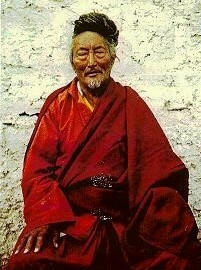
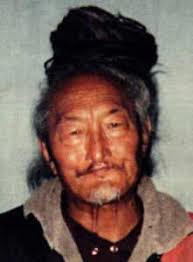
Biography of The Late Kyunga
Konchok Zopa Gyatso Rinpoche
(1911 - 1980)
Kyunga Konchok Zopa Gyatso Rinpoche completed thirty-five years of retreat
during his life. He was an accomplished master of Mahamudra and the Six
Yogas of Naropa. He was also a terton who discovered Dharma
scrolls of the Dakinis and other Dharma treasures. Pachung Rinpoche always
praised him as the manifestation of Dombi Heruka, the Indian mahasiddha.
After 1970, Kyunga Rinpoche and Pachung Rinpoche were peerless in their
contributions to the preservation and flourishing of the precious Drikung Kagyu
Lineage.
Kyunga Rinpoche was born in 1911, in Chunbo within Kham. His family
belonged to the Sakya Khon, or the female descendants of the Sakya clan.
His father, Noundrup, and his mother died when he was very young. He had
many brothers and sisters. A few years after his birth, his family moved
to the Drikung area of Tibet. Their family home is just below Drikung Thil
Monastery.
At the age of four he took refuge in front of the Lord Jigten Sumgön statue in
the main hall of the Drikung Thil Monastery, receiving the name Konchok Zopa
Gyatso. Afterwards he remained in the monastery learning the monastic rituals,
mudras, and instruments. When he played with the other novices he
always spoke of building a retreat hut and spending his life in retreat.
Even as a child he was recognized by the other monks as a leader, forming a “Kyunga” group.
At the age of fifteen, due to his exemplary behavior, he was given the honor of
being named umze, or music master, of the monastery. But he had the wish
to study philosophy in depth, therefore he went to the Sunray's Garden College
which, at that time, was located in Yamari. He studied under the teacher
Nayrong Tulku Jamyang Wangje, an emanation of the Lion's Speech of Manjushri and
a heart disciple of the famous Dzogchen Khenpo Shenga. Within five years,
he completed perfectly his study of the Thirteen Great Indian Commentaries and
received the full cycle of the Lonchen Nyingthig teaching.
Following this, he received his bhikshu vows from Shiwa Lodro, (1874- 1943) the
34th throne holder of the Kagyu Drikungpa and Sixth Chetsang Rinpoche. Also from
him, he received many empowerments and oral instructions. After graduation
from college, he received the Fivefold Mahamudra instruction from Mahasiddha
Ankong Rinpoche and Drikung Thil's retreat master Tseden Rinpoche. In
addition, he offered a small piece of gold to a famous retreatant Dorje Logga,
receiving the oral instructions of Mahamudra and MahaAti. He received the
Six Yogas of Naropa four times: from His Holiness Shiwa Lodro, Tseden
Rinpoche, Ankong Rinpoche and Tsar O Dorje Logga. Tseden Rinpoche
was his retreat master for five years in Drikung Thil. He was the vajra
brother of Mahasiddha Pachung Rinpoche and Khenpo Namnang, a famous Madyamika
master, who were his classmates in college and retreat. Pachung Rinpoche
always spoke of himself as Naropa and Kyunga Rinpoche as Dombi Heruka.
Once, these three vajra brothers walked together through a place named Tsega
Tan. Unnoticed by his friends, Kyunga Rinpoche rested on a large rock
while the others walked ahead to Lha Tho. They noticed he was not
with them and waited for him. When he rejoined them, they saw that he was
holding a treasure purba. He said "If our practice is the same, please
reveal this kind of terma purba."
Since Kyunga Rinpoche had special accomplishment in Fivefold Mahamudra and the
Six Yogas of Naropa, His Holiness Shiwa Lodro sent him to Milarepa's special
place, the holy mountain Labchi, to be head of the monastery, or Vajradhara,
there for three years during the 1930s. Holiness promised him that
after completing this duty he was free to roam as a yogi. Lapchi is
a holy place of Chakrasamvara's right ear. Due to the heavy snowfall, it
is completely isolated for 3- 4 months every year. As the Vajradhara of
Lapchi monastery, he frequently gave instructions for retreatants. He
remained there for 6 or 7 years. He was known to often sing dohas,
realization songs. Today, some of these, such as Praise to Naropa,
have been recorded by his disciples.
After completing this duty, with Holiness Shiwa Lodro's permission, he traveled
by himself to Tsari, Mt. Kailash, Nepal's Dolpo, Yanglse, as well as Bodhgaya
and Varanasi in India. On this pilgrimage he stayed in retreat for months
at a time in each place. Finally he reached the holy place of Guru
Rinpoche named Sansang, which is one month journey by foot from Mt. Kailash.
He stayed in retreat on this high mountain for 15 years. Since he
was not known to the local people they called him Tsar Ugyen Tsampa, which means
the retreatant on Guru Rinpoche's rock.
As a terton, he discovered some dakini scrolls in this holy place.
Although he discovered the objects, in this life he did not reveal the teachings
within them because he was not fully aware of them and also the necessary
conditions did not arise. But at the age of 37, he got permission from the
dakini directly to use a human consort. One day he dreamed a dakini
was calling him. Upon awakening, he walked in the direction of the dakini
and found an 18 year old girl with all the qualifying signs, who he took as a
consort. After lunch she would carry his meditation cushion following him
up the high mountain where he would practice mahamudra. Sometimes at
midnight she would even follow him to the cemetery to practice Chod.
The snow mountain caves of the Sansang area are extremely cold and windy but due
to his high accomplishment of inner heat he remained comfortable. During
this time the villagers became aware of his realization and came to him for
teachings of Fivefold Mahamudra and Six Yogas of Naropa. After practicing
his instructions, they had very good results. Thus these precious,
difficult, and profound teachings were well spread.
In the 1950's, conditions became worse. One day he alone went to a far
high mountain. He revealed an old black paper. On it was written
"Now it is not good to stay here. Return to Drikung Thil".
Therefore, due to the protector's direction, he returned to the Drikung
monastery. Some of the monks could not accept the fact that he had a
consort and was conducting himself as a mahasiddha. So before 1959, he departed
for Gantok of Sikkim.
There he met the second Dzongsar Jamgyang Khytsen, Chokyi Lodro. They
became close friends and always discussed Dharma together. At that time,
he had two monk disciples who came with him to Sikkim. Because of their
good understanding of Mahamudra and the Six Yogas of Naropa, they were poisoned
by those who envy them; one in Sikkim and one in Bhutan. Only Rinpoche and
his consort survived.
From that time on, no one knew of his realization; he just worked anonymously on
the road making teams along with the ordinary Tibetan refugees.
Daily after heavy labor he received one and one half rupees for survival.
Thus he remained hidden for many years, never giving public teachings.
When the road reached Bir in north India, a famous Kagyupa lama with many
disciples, Sansang Lama (himself well practiced in Six Yogas of Naropa)
recognized him as his former teacher and paid him public respect. People
became aware that he was far from ordinary. When Sansang Lama died, a
rainbow appeared in the sky with a rain of flowers as well as many other
auspicious signs. People thought if his disciple is so realized, then how
much more must be his teacher, Kyunga Lama. During this period of time in
Bir he had many discussions with the tutor of the Forty-first Sakya Trizen,
Khenpo Rinchen regarding the view of Mahamudra and so forth. Also they
compared the complex mudras for Vairochana within the two lineages.
In the beginning of the 1970's, the road workers reached Manali.
There, the first Tukse Rinpoche (1915-1983) of the Drukpa Kagyu lineage came to
know him. After deep discussion of Mahamudra in the Kagyu lineage, Tukse
Rinpoche was so moved by his high realization that he praised him. Tukse
Rinpoche then requested him to Turn the Wheel of Dharma, but he humbly replied
that he was now old. However, Kyunga Rinpoche did bestow the innermost
oral instruction of karma mudra to Apo Rinpoche, who is the grandson of
Mahasiddha Shakya Shri of the Drukpa Kagyu lineage.
With an introduction from Tukse Rinpoche, the ninth Togden Rinpoche (1938 -
) of Drikung Kagyu, Ladakh Choje came to know of the arrival of Kyunga Rinpoche.
He arranged special permission for Kyunga Rinpoche to reside in Ladakh, where
there were many strong Drikung monasteries (at that time Tibetan refugees were
not allowed to be near the boarder areas such as Ladakh). There he stayed
first in Sansang Phari, a branch monastery of one of the three main monasteries
of the Drikung, Shaghoku.
At that time he was the most qualified retreat master of all the Drikungpas in
India, therefore he was requested to lead a three year retreat. About
1974, the first three year retreat began and included Lama Sonam Jorphel
Rinpoche (1939 - ) and 9 other disciples. Conditions were so poor that the
monastery could only offer the daily requirements for Kyunga Rinpoche alone.
For the other retreatants, they could only offer fire wood. Since
they did not have sponsors, the students had to fund the retreat themselves.
Kyunga Rinpoche took upon himself the difficult responsibility of caring for his
students. Conditions were so hard that during the winter snow was blew
into the rooms and the students had to construct a stove with a little iron, in
the summer the roof leaked during the rains. The students requested many
times to leave retreat in order to beg for offerings but he would not allow them
to leave. He tried his best to help everyone, so they could concentrate on their
practice.
Kyunga Rinpoche had one small bottle and upon it he made a line with his knife.
Whenever sponsors offered him any kind of grain he put it in the bottle.
Whenever the grain went above the line, he gathered all the students together
and offered a tsog When a period of the retreat is completed the
students must offer a fire puja. Kyunga Rinpoche always tried his best to
acquire all the texts, ritual objects such as dorje and bell to make the
ceremony possible during that difficult time. His students were overjoyed
to have sets of a dorje and bell. Kyunga Rinpoche for these three years fully
saw to the training of his students, going around the retreat house every
morning. They could hear his footsteps whenever they listened and could
always feel his presence.
In terms of practice, he was very strict. During the time of prostrations
in the winter, even when their ears and arms were nearly frozen, the students
were not allowed to use prostration boards and were required to prostrate on the
bare floor. Even though many became sick, no one left the retreat.
Within the few days between the retreat periods, Kyunga Rinpoche did not waste
time. The students studied the rituals and mudras of Chakrasamvara,
Vairochana, and so forth. Kyunga Rinpoche's only thought was to continue
the practice lineage perfectly with no error.
Around this time Kyunga Rinpoche was invited by Drukpa Tukse Rinpoche to Tsartzi
Monastery, where he passed many rare oral instructions of the method of practice
according to the Drikung Kagyu lineage. This satisfied Tukse Rinpoche's
every wish. Afterwards Tukse Rinpoche wrote a letter to the retreat
students, encouraging them to practice well the guidance of this rare master.
Since everyone witnessed the good results of the first three year retreat, the
monks of Lamayuru monastery begged him to come to their monastery.
Rinpoche replied, "If there are monks willing to do retreat, I will come".
Therefore a second retreat began in Lamayuru in 1978 with twelve students
including Khenchen Konchog Gyaltshen Rinpoche (1946 - ). At the end of
that year, in November, H.H. Chetsang Rinpoche (1946- ) joined the
retreat. He received at that time the Thirty-seven Practices of a
Bodhisattva and many long life initiations from Kyunga Rinpoche.
Gelugpa Gelek Rinpoche accompanied His Holiness Chetsang Rinpoche and he
requested Kyunga Rinpoche in this way, “His Holiness is
the reincarnation of your root lama, H.H. Shiwai Lodro, a true mahasiddha who
has come again to samsara, not an ordinary being. He has experienced
enough suffering in China, so please allow him to receive special consideration
of fewer prostrations and offer to him the entirety of the lineage quickly."
Kyunga Rinpoche was sad to hear this and declined without hesitation. He
said, “Since he is the incarnation of HH Shiwai
Lodro he must practice more than others to prove his quality." When Gelek
Rinpoche returned to Dharamsala and reported this to H.H. the Dalai Lama, His
Holiness was so happy that he folded his palms in praise saying, “Kyunga Rinpoche is a real guru!” Kyunga Rinpoche emphasized to H.H. Chetsang
Rinpoche: "It is not important how long it takes, when you do the prostration
you must fully prostrate". H.H. completed 300,000 prostrations. His
attendants were amazed by his strength which enabled him to finish them in a
very short time.
During this time conditions were very poor as well. The retreatants were happy
to have even a thin blanket. H.H. Chetsang Rinpoche had only recently
reached India from Tibet. His conditions were not much better. His
attendant Lama Konchok planted potatoes outside the retreat hut and sold them to
the Indian army. This income he offered to his Lama, HH Chetsang Rinpoche,
to maintain his retreat. Kyunga Rinpoche lived in a tent. As before,
he kept all the offerings from his sponsors and put them under his mattress.
Periodically he would share it with all the students. He never wore the
good clothes offered by his sponsors. Whatever donations he received
for pujas conducted for the dying, such as gems and jade, he crushed and mixed
with mud to make clay stupas, dedicating them for the one who had died. He
never kept anything for himself or his family Even to his own
daughter never did he give jewelry or fine clothing. His daughter only had
one set of clothes although she requested many times to have a set of good
clothes to entertain guests. Once in a tsog there were many desirable
things that his daughter longed to eat, but still he only gave the offerings to
his students giving nothing to her. His family had no savings and
never had supplies for the next day's food, yet he was content. His full
compassion was directed to his Dharma students, demonstrating the dedication of
a true yogi. He always warned people "Monastery property and offerings are
the source of argument." Once he pointed to his torn clothing to his disciples
saying "In this age, who can still wear this kind of clothes? This is a
miracle."
In the 1980s, H.H. the Dalai Lama and H.H. Chetsang Rinpoche were invited by the
third Ontul Rinpoche to an inauguration for his new monastery located beside Tso
Pema, a holy lake of Guru Rinpoche. Among the crowd of people H.H. the Dalai
Lama noticed Kyunga Rinpoche and walked over to greet him. Before he could
offer his kata, the Dalai Lama offered the kata back to him and touched his
forehead with his own, a sign of great respect. The Dalai Lama said to
him, “You are an uncommon lineage holder of the
Drikung Kagyupa, please remain alive for a long time. Come to Dharamsala to do a
long life puja for me and for yourself.”
During the time of the inauguration, Kyunga Rinpoche taught the Jewel
Ornament of Liberation and Rigdzin Chokyi Drakpa’s (the 24th
throneholder of the Drikungpa (1595 - 1659)) Sunray Commentary on Gong Chik,
the Single Intention of the Buddhas and Essence of Mahayana. He
also bestowed the great empowerment of Chakrasamvara and Vairochana to the
public.
Kyunga Rinpoche said to his disciples “Gong Chik is the
necessary text for everyone to study, and if you want to learn this text Khenpo
Rinchen is the best teacher. If you want to do retreat, it is also good.
Your mind is your lama.” Afterwards disciples were unable to
receive a teaching from Khenpo Rinchen on Gong Chik, so he himself gave
all three main commentaries to the disciples including Khenchen Konchog
Gyaltshen over a four month period. Thus he demonstrated his expertise in
study as well as practice. Following this, he was invited by Ontul
Rinpoche to establish another retreat course at the Tso Pema monastery, in which
he completed teaching from Ngondro to the Chakrasamvara retreat.
Kyunga Rinpoche was the kind of teacher who could give teaching according to the
intelligence of each disciple. He only liked disciples who did retreat
practice. He would not waste his teaching on those who would not practice,
therefore it was not easy to receive teaching from him. For ordinary
people he would always take every opportunity to teach. He knew the karmic
causes and effects. He began by teaching simply to attract people, so they might
desire to learn and practice. Once hooked, he became very strict with
them.
Rinpoche didn't like his disciples to go to homes to do pujas in order to make
money. Nor did he approve of relinquishing their monastic vows.
Once, one of the retreatant's mother died, but Rinpoche did not allow him to
break retreat. He said “What is the use
of going home? What power do you have? It is better to remain in retreat
here and dedicate the merit.” Rinpoche thought if a puja is really
necessary, it would be better to do it in a retreat room at the monastery than
to go to the sponsor's home because you are less disturbed and you have all the
ritual requirements easily available which makes the puja more effective. If you
go out to do the puja, it is bad for the practitioner and the sponsor because it
is less effective.
Rinpoche also had the capacity to know and teach non-human beings.
During the time of choosing the location of retreat huts, he pointed out to the
people present, “There is a naga; there are non-humans.
Avoid those places and do not disturb them.” Another time, an area was afflicted with
parasites in their water that caused people to have internal bleeding.
These people had to move their cattle far distances for drinking water.
When Rinpoche was invited to do a puja there, he talked to the water insects
very seriously saying, “You cause the
deaths of other beings, making much suffering. This is wrong!” If you didn't know Rinpoche, he would have
seemed crazy as though he was murmuring to himself. Not long after
that the parasites disappeared responding to his teaching. He was also able to
call rain in times of drought.
At the time Kyunga Rinpoche was invited to Dharmsala to perform a long life
prayer for H.H. the Dalai Lama, he was involved in a bus accident on his way
back to Ladakh . Due to the panicked crowd he received serious internal
injuries. Because of his level of practice, the signs of injury did not
appear immediately. Two months later, the effects of the injury caused vomiting
of whatever he ate. He grew very weak, but he still gave whatever teaching
was necessary for the retreatants, not giving any thought to his own health.
Lamayuru Monastery is remote, far from any medical care and very poor.
Though Lama Sonam Jorphel visited him every day offering Tibetan medicine, there
were no signs of recovery. Finally, ten months after the accident and two years
into the second three year retreat in Lamayuru, Kyunga Rinpoche he made a
decision to leave his body. He predicted the date of his parinirvana to
his main successor, Lama Sonam Jorphel Rinpoche. He said to his
retreatants, “No need to come
out of retreat. Just remain in Mahamudra samadhi. Practice Guru Yoga,
mixing your mind with the guru is enough.”
When H.H. Chetsang Rinpoche received this message he requested to meet Kyunga
Rinpoche. Therefore Kyunga Rinpoche gave him special permission to meet
for one half hour on the 29th winter day of the Tibetan calendar at 4 pm.
Kyunga Rinpoche's speech was growing unclear but he still gave much important
advice to H.H.Chetsang Rinpoche. Especially he said, “In the past you couldn't leave Tibet and I worried
about you. After you came out you went to America and I worried that
you would not head the lineage. Now you are in India and you have
perfected study and practice so I can die without any hesitation.
All dharmas are impermanent. Now you have the responsibility of the
Drikung Kagyu lineage. It is a heavy duty, but you must take it on.
Go back into retreat.”
After seeing H.H. Chetsang Rinpoche, Lama Sonam Jorphel returned to serve
Rinpoche. Usually Kyunga Rinpoche never said to people I'll see you
tomorrow, but this time he did. “Come
tomorrow.” he requested. On that day he asked that his mandala offering
set, which was made of gold and silver, be ground into powder and used as
decorative paint for a Buddha statue so that it not be the cause of arguments.
In 1980 on the 30th day at sunrise, when he was 70 years old, he asked for H.H.
Shiwai Lodro’s picture and made offerings and prayers.
He held the hand of Lama Sonam Jorphel, his only permitted attendant, and said, “At the time of
death there is no difference between the seated meditation posture and the
auspicious sleeping posture, but I choose the latter. Now we should recite
the prayer to the guru.” They recited this three times
together, he mixed his mind with that of his root lama, entering the state of
mahamudra. Passing into the state of nirvana, he remained in meditation
for 6 days. During this time the sky was cloudless and blue in color, a sign of
his accomplishment in mahamudra. When his body was cremated, clouds in the
shapes of auspicious signs appeared. Afterwards, many relics were found.
With these Lama Sonam Jorphel built a stupa at Lamayuru.
Colophon: This
short introduction of Kyunga Rinpoche's biography was collected from interviews
with H.H. Chetsang Rinpoche, Khenchen Konchog Gyaltshen Rinpoche, Lama Sonam
Jorphel Rinpoche, Lama Tenzin, Drupon Samten, and Kyunga Rinpoche's consort and
daughter. Although they were consulted many times, this is but a small
portion of his rich Dharma activities. Any imperfections in the biography are
due to my own limited capabilities and should be forgiven. Thus this
biography was compiled and completed on June 7th of 2001 in Chinese by Acharya
Jack Huang. Translated into English on March 11, 2002 by Acharya Jack
Huang and Ani Nyima Drolma in Songsten Library, North India. By this merit
may Kyunga Rinpoche return swiftly to benefit beings and uphold the Kagyu
Drikung Practice Lineage. May all be auspicious.
Last updated on 2020-11-04